

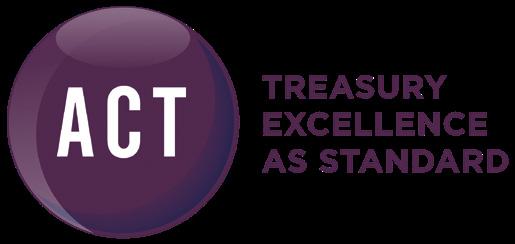
JOINING THE DOTS How finance is key to supply chain resilience and sustainability PAYMENTS New global standard aims to create a frictionless system 13 18 THE MAGAZINE OF THE ASSOCIATION OF CORPORATE TREASURERS ISSUE 2 2023 FUTURE TRENDS Four ACT forum panellists swap notes on what lies ahead 25 MENTAL HEALTH Helping you and your team cope in stressful times
Our focus today is on the things that could have the biggest impact on your business tomorrow. With specialist teams – from global markets and trading, to financing, risk management and transaction banking – we aim to deliver the strategic advice and expertise you need to grow confidently and quickly.
natwest.com/corporates

The Treasurer
is the official magazine of The Association of Corporate Treasurers
150 Minories, London EC3N 1LS United Kingdom +44 (0)20 7847 2540 treasurers.org
Policy and technical Naresh Aggarwal, Sarah Boyce, James Winterton
Commercial director Denis Murphy

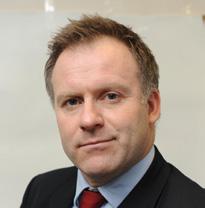
Director of marketing and communications Anne Hogarth
Technical review Ian Chisholm, Steve Ellis, Anu Mensah, Joe Peka, Alison Stevens, Neil Wadey, Peter Walker-Smith
ADVERTISE WITH US
For advertising and sponsorship opportunities, contact deputy commercial director Simon Tempest +44 (0)20 7847 2580 stempest@treasurers.org

THE TREASURER ©2023
Published on behalf of the ACT by CPL 1 Cambridge Technopark, Newmarket Road, Cambridge CB5 8PB +44 (0)1223 378000 cpl.co.uk
Editor Philip Smith phil.smith@cpl.co.uk
Managing editor Helen King
Publishing editor Sophie Hewitt-Jones
Art director Kevin Reed
Cover illustration iStock / DrAfter123
SUBSCRIPTIONS
Europe, incl. UK (per annum)
1 year £285 | 2 years £405 | 3 years £525
Rest of world
1 year £320 | 2 years £495 | 3 years £655
Members, students and IGTA/ EACT members
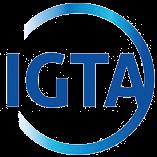
[Self-certifiedmembersofNationalTreasury Associations,includingtheAFPintheUS]
1 year £142 – UK and Europe (MUKEU)
1 year £185 – rest of world (MRoW)
For information, visit treasurers.org/ thetreasurer/subscription
FUTURE TENSE
There’s nothing like a banking crisis to focus financial minds. The recent events in Europe and the US were a hot topic at this year’s ACT Cash Management Conference. Questions were asked about whether or not the collapse of individual banks could lead to a global systemic meltdown similar to the one witnessed in 2008. While the message was a clear “Don’t panic!”, it was equally clear that treasurers need to keep on top of the basics –security, liquidity and return. Technology is helping in this respect, but there was little doubt in the room that now is the time for treasurers to demonstrate their worth.
I am sure this will be a recurring theme of the ACT’s Annual Conference, which this year is being held in Newport, Wales (in fact, you might well be reading this letter while sat in the auditorium of the ICC). The overarching theme is managing financial risk at times of crisis and, with this in mind, I asked new ACT president Joanna Bonnett, head of sustainability at PageGroup, and PwC’s Robert Waddington to expand on what treasurers can be doing – you can read their insights on p20-21.
Of course, there is the nagging worry that the strains within the financial markets (crisis or no crisis) will pile yet more stress onto the treasury community. Mental health is a real issue – it is a subject that needs to be talked about in an open and honest way. Lawrie Holmes spoke to treasurers and mental health experts to discover what organisations
can and should be doing to help their team members through these difficult times. His article begins on p13 – please share it with your colleagues.

Our cover feature for this issue focuses on supply chains – how they are only as strong as the weakest link and what the future of supply chain finance holds for an ecosystem that has been under pressure for some time. Innovation will be the order of the day if supply chains are to be resilient and sustainable – it is about more than ensuring the vegetable aisles in our supermarkets remain fully stocked, but that is a good starting point.
We also hear from Geoff Hopkinson, corporate finance manager in Haleon’s treasury group. He is urging businesses to consider recruiting military veterans to their ranks. His argument is convincing –veterans are used to complexity and using their initiative, and come with honed projectmanagement skills. And he should know, having served as an officer in the Royal Marines for 12 years.
Finally, can I recommend our feature on the future? The thoughts of four forward-looking experts start on p25 – right or wrong, let us know your own views.
phil.smith@cpl.co.uk
Follow us on Twitter @thetreasurermag
CONTRIBUTORS
of
Lawrie Holmes on how to take care of your mental health during these stressful times
PAGE 13
Kallum Pickering argues that recent bank collapses will not lead to a systemic failure of the financial system this time

PAGE 22
Megha Merani reports on developments at the ACT Middle East Technology and Innovation Conference
PAGE 34

treasurers.org/thetreasurer ISSUE 2 2023 3
THIS ISSUE’S
The copyright of all editorial in this magazine is reserved to the publishers. None of the articles published may be copied, duplicated or reproduced in any form without the prior consent
The Association of Corporate Treasurers. The Association of Corporate Treasurers, the publisher and editor cannot accept responsibility for any claim which may be made against a contributor arising out of the publication of any article or letter. The views and opinions expressed in this magazine are not necessarily those of the Council of The Association of Corporate Treasurers.
This magazine is printed by the Manson Group in St Albans, UK on paper certified to be from sustainable European sources. The Manson Group operates a system to manage and reduce their environmental impact. Find out more: tmgp.uk/enviro and www.mansongroup.co.uk/ environment ISSN: 0264-0937
“Now is the time for treasurers to demonstrate their worth”

Barclays Bank PLC is registered in England (Company No. 1026167) with its registered office at 1 Churchill Place, London E14 5HP. Barclays Bank PLC is authorised by the Prudential Regulation Authority, and regulated by the Financial Conduct Authority (Financial Services Register No. 122702) and the Prudential Regulation Authority. Barclays is a trading name and trademark of Barclays PLC and its subsidiaries. 04/23. KX11444-80.
Picture Banking See things differently
Big





treasurers.org/thetreasurer ISSUE 2 2023 5 Contents 34 What do you think of this issue of The Treasurer? Please write to phil.smith@cpl.co.uk or tweet @thetreasurermag Shutterstock / Golden Sikorka 40 37 BEST PRACTICE37 CASH MANAGEMENT CONFERENCE A look at the hot topics, including cyber security and the need to ensure liquidity 40 A MILITARY OPERATION Veterans have skills that could make them ideal treasury candidates 42 IN DEMAND ‘We’re as busy as ever,’ says recruitment firm 43 PAYING DIVIDENDS New systems may improve efficiency 45 CALENDAR ACT events and course dates 46 MEMBER SERVICES Find out more about the P&T advisory panel 48 A DAY IN THE LIFE IHG Hotels & Resorts’ Hailey Laverty 50 END NOTES Lisa Dukes on the new modus operandi LONG VIEW07 JOINING THE CHAIN GANG Treasurers are looking at innovative finance solutions for supply chain challenges 13 MENTAL HEALTH How to help you and your team cope in turbulent times 18 PAYMENTS CROSSROADS Opportunities lie ahead thanks to a new standard – but there may be difficulties, too 20 BOARDROOM QUESTIONS What steps should you be taking now to protect your cash? 21 MANAGING RISK New ACT president Joanna Bonnett urges treasurers to keep their skills up to date 22 IS HISTORY REPEATING? Are fears we are heading to a 2008-style crisis wide of the mark? 23 INFOGRAPHIC Finance leaders shift focus to product and service pricing, McKinsey survey reveals 25 FUTURE OF TREASURY Four panellists from the recent ACT event swap notes on future trends 30 COMMUNITY ACTION Award-winning Places for People on how the social enterprise is moving away from the traditional financing model 32 VIEW FROM… Two lawyers explain how they work with treasurers 34 TECH FOCUS Megha Merani reports from the treasury technology conference in Dubai, and finds digitisation is more important than ever 13 25
8 November
JW Marriott Grosvenor House Hotel, London
Book your table for 10 and celebrate 40 years of the ACT Annual Dinner. Enjoy an evening of fine dining, networking and entertainment with your treasury friends and colleagues.
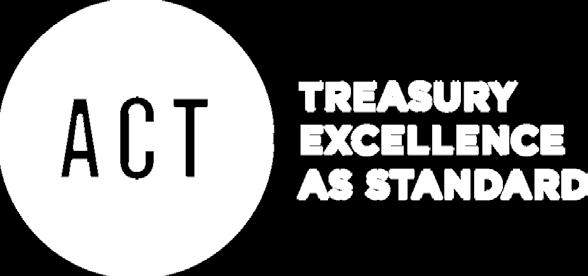



"The whole event; the location, the organisation, the superb food and wine, but mostly the deep impression the speakers had on me along with the conversations I enjoyed with other guests on our table was absolutely brilliant."
-Senior Director, WTW
TR EA S U RERS.ORG/ ANNUA LDI NN ER2 3 #ACTDINNER
LONG VIEW
Analysis of long-term trends
JOINING THE CHAIN GANG
The recent shortage of tomatoes in UK supermarkets made national headlines and offered a salutary reminder of the fragility of global supply chains. Whether down to Brexit pressures or unseasonal frost in North Africa and Spain, the empty shelves underlined a lesson that supply chains, and their resilience, are at the heart of a company’s ability to continue serving customers and stay in business.
THIS ISSUE
13
MENTAL HEALTH
Advice on how you and your team can combat stress
18
HITTING CROSSROADS
How ISO 20022 is changing the payments landscape

20

MANAGING RISK
In times of crisis, financial risk tops board agenda
treasurers.org/thetreasurer ISSUE 2 2023 7
Treasurers are increasingly looking at innovative finance solutions to ensure supply chain resilience and sustainability.
Gavin Hinks reports
/
Shutterstock
Golden Sikorka
Increasingly, treasurers are at the heart of efforts to shore up supply chain resilience. Driven by a raft of geopolitical and social issues, the focus on supply chains is shifting away from the old ‘just in time’ model. Whatever the driver, treasurers are now integral to maintaining supply chain resilience and sustainability. According to Rebecca Harding, founder of Coriolis Technologies, a data and analytics provider for the trade finance industry, this will bring about a transformation of the treasurer’s traditional role.
“Treasurers are now in a position where they have to manage the reputation, financially and operationally, of large corporates and that’s something that goes way beyond anything that was originally expected of corporate treasurers,” she says.
Supply chains and their management have changed in recent years, pushed by a number of factors all coming together at once: regulatory reform, geopolitical uncertainty, and the battle against climate change. For the UK and Europe, Brexit has obviously had an effect, too.
It was the impact of the COVID-19 pandemic, however, that had the most influence on changing the way companies think about their supply chains. With whole economies brought to a standstill by lockdowns, supply chain managers concluded that ‘just in time’ was to be replaced by ‘just in case’ and that ‘resilience’ was now the key word.
COVID-19 was not the only factor in this shift. Further disruptions were to follow when Russia invaded Ukraine, adding to increased volatility for suppliers, soaring energy prices, and record levels of inflation.
The war has also brought sanctions, placing even more focus on supply chains and customers. In the meantime, a slew of other regulations will force a global focus on supply chains and their sustainability as governments look to battle climate change.
Regulation
The UK’s Procurement Bill will demand more supply chain transparency, while the EU’s Corporate Sustainability Reporting Directive and Corporate Sustainability Due Diligence Directive will force big companies to
consider human rights and the environment in their supply chains through the imposition of more disclosure requirements. In the US, companies are coming to terms with President Joe Biden’s executive order of 2021 aimed at promoting “resilient, diverse and secure supply chains”.
One of the most significant changes, however, is the Task Force on Climate-related Financial Disclosures (TCFD) rule, asking companies to disclose their Scope 1, 2 and 3 emissions – Scope 3 being emissions in supply chain members.
For credit providers, Scope 3 emissions will be all-important, and the need for disclosure is causing banks and lenders to put pressure on clients to not only be transparent about their carbon emissions, but to also bring them down through credible transition plans.
Reputation
Enter the treasurers. “In effect, it’s becoming not just about credit controls and credit management and budget management, it’s actually, critically, about the reputation of the business,” says Harding. “Reputation of the business in environmental terms is becoming the new financial stability.”
Mirka Skrzypczak, head of working capital
LONG VIEW
8 ISSUE 2 2023 treasurers.org/thetreasurer
(2021)
than 2020
SUPPLY CHAIN FINANCE MARKET = $1.8 trillion
38% higher
and trade product at NatWest, agrees, saying companies now have to assess supply chain vulnerabilities through “a number of lenses”.
“This is no longer just financial; this is no longer about continuity and availability of goods. What we also now have – and this is super serious – is sustainability. We have to always look at ESG [environmental, social and governance] because, going forward, this is what’s going to make or break companies.”
The job now for treasurers is to consider how they secure the resilience and sustainability of suppliers given the tools they have available to them in finance.
Luca Gelsomino, a treasury and supply chain expert at the University of Groningen, and author on the subject for the World Economic Forum (WEF), believes treasurers have reached a new “moment” in their role, where they will be using financial tools to help shore up supplier resilience.
“Treasurers are more involved in the discussion around supply chain management than they were before,” says Gelsomino. “That implies new knowledge and skills for the treasurer to understand how intricate a supply chain can be, especially for a global multinational company.”
According to Harding, treasurers have yet to acquire the “horizon scanning” networks and techniques that would allow them to find alternative supply chains. It remains a “work in progress”, from the treasury point of view.

Transparency
Treasurers will need to know their supply chains in depth, with full transparency, so they can identify and understand where the risks lie, and where financial tools can be applied. “They need to think about the entire supply chain, end to end,” says Skrzypczak, adding: “You need to map your supply chain; you really need to understand it and then start asking questions about where the vulnerabilities are.”
Supply chain transparency is not an easy task. While a large corporate will have sight of who its immediate suppliers are, visibility further down the chain, into the tiers below, may be opaque or very difficult. This may mean treasury will have to be closer to supply chain managers and procurement – the “holy trinity”, as Skrzypczak dubs them – to achieve the kind of visibility required for treasurers to act.
There are a number of tools open to
treasurers to support suppliers, but whether they are intended to help them through a difficult patch or support their transition to low-carbon status, they all involve helping suppliers access liquidity.
Accessing liquidity
One approach would be supporting suppliers with purchase order finance –essentially, cash provided to a supplier by a financing company so goods can be produced, then payment is sought from the end client.
“It’s critical in apparel, where you receive your order sometimes six months before you send the invoice,” says Gelsomino.
Perhaps the most significant tool to hand for treasurers, however, is supply chain finance (SCF). In this tripartite structure, suppliers sell their invoices to a financing company, which then invoices the buyer, or end user, when goods are delivered.
The advantages are clear. It aids suppliers, cements the bond between them and the client, and, according to financing companies – many of them banks – it is easy to implement.
That it has become popular is clear from the activity under way. The World Supply Chain Finance Report finds that, in 2021, volumes reached $1.8tn, up 38% on the previous year. In 2015, the supply chain finance market stood at just $330bn. Asia has seen the biggest growth (50%), but Europe and America have also clocked hefty spikes of 45% and 37%.
According to the report, much of the growth “reflects the huge impact of the coronavirus pandemic and the recent Ukraine-Russia conflict”.
SCF has not been without its hiccups, however. Scandal over the collapse of Greensill in 2021 cast a shadow over SCF, with many concerned that it could cause a loss of confidence. However, scrutiny of Greensill’s business model, appears to have allayed fears.
treasurers.org/thetreasurer ISSUE 2 2023 9 LONG VIEW
“ TREASURERS ARE MORE INVOLVED IN THE DISCUSSION AROUND SUPPLY CHAIN MANAGEMENT THAN THEY WERE BEFORE”
LUCA GELSOMINO
SCF VOLUMES ASIA $324bn AFRICA $29bn EUROPE $455bn AMERICA $995bn
Rebecca Harding, founder of Coriolis Technologies
What some observers now advocate is increased use of a specific kind of SCF –reverse factoring. Though first used 40 years ago, this structure sees the end buyer enter the arrangement to provide an ‘obligation’ to pay invoices to a finance company, usually a bank. The finance company then pays the supplier up front, easing their liquidity needs. The great advantage of this arrangement is that the buyer, very often bigger and with healthier finances than their suppliers, assumes the credit risk.
Reverse factoring
The arrangement has drawn real support as a means of securing suppliers and stabilising supply chains. But the structure is also being used as a means of encouraging lower carbon emissions. Writing for the WEF website, Gelsomino – along with Frank Waechter, head of group treasury at sports brand Puma – describe how new reverse factoring models have been used to persuade suppliers to reduce their carbon emissions by offering the incentive of lower fees if they score well on a ‘sustainability rating’.
Puma has a programme called the Forever Better Vendor Financing Programme, while German consumer goods company Henkel, partnered with Deutsche Bank, won the 2022 Global Supply Finance award with a programme that linked lower costs for suppliers to ESG scores from rating provider EcoVadis.
Of the 400 suppliers involved in an earlier SCF programme, almost all moved to the sustainability scheme. Judges noted the scheme relied upon “close cooperation” between treasury, procurement and sustainability teams at Henkel.
“The treasurer,” says Gelsomino, “is playing much more of a role in working together with the procurement officer and the supply chain officer, and that is, indeed, a trend that we have seen much more strongly in the past two to three years.”
There are also alternative support structures in use, in particular what is known as ‘deep tier’ financing. This approach sees treasury at end customers provide support not just to tier 1 suppliers, but also to those in tiers further along the supply chain. Such suppliers are mostly smaller companies and more likely to be vulnerable to economic disruption.
Like SCF, the approach uses the end buyer’s credit rating to support financing for suppliers. But instead of extending that aid only to tier 1 suppliers, it goes deeper, to benefit the ‘supplier of suppliers’. Blockchain technology is used to link the supply chain ecosystem and the credit rating to suppliers further down the chain, and maintain confidentiality over supplier pricing. Deep-tier financing is regarded by many to be in its infancy, though there are headline examples, such as DBS Bank in Singapore with what it calls its “multitiered financing facility”.

Digital platform
Concerns
remain, however.
One worry is that it puts too much power in the hands of large corporate buyers when it comes to negotiating terms, and lacks transparency. Some speculate that suppliers seeking to access a deep-tier scheme could be forced to discount their
10 ISSUE 2 2023 treasurers.org/thetreasurer
LONG VIEW
“
YOU NEED TO MAP YOUR SUPPLY CHAIN; YOU REALLY NEED TO UNDERSTAND IT AND THEN START ASKING QUESTIONS ABOUT WHERE THE VULNERABILITIES ARE” MIRKA SKRZYPCZAK
Luca Gelsomino, a treasury and supply chain expert at the University of Groningen
services too much and, therefore, undermine their own working capital.
That said, in March last year Citi Bank said it was working with Stenn, an online SME financing platform, to provide a deep-tier solution. According to Parvaiz Dalal, global head of payables finance at Citi, deep-tier financing – although it may be in its infancy – offers the opportunity of improving liquidity beyond tier 1 to suppliers further along the chain who may be the key point of ‘value’ in a supply chain.
Citi uses a digital platform to connect the suppliers with finance and buyers. Digitisation, he says, helps establish the authenticity of purchase orders and helps eliminate fraud.
Dalal adds that, though there are criticisms of deep-tier finance, suppliers have “100% discretion” whether they use it or not. If a supplier chooses to go ahead, “it definitely adds a lot of value”, he says. It offers an “incremental line of credit”, a digital solution and “flexibility to increase supplies to a buyer”.
Supply chain finance may be useful, says Dalal, but deep-tier financing goes further. “If you really use that solution, end to end, then the entire resiliency that you want to create can actually happen.”
REVERSE FACTORING FLOW CAN SECURE SUPPLIERS AND STABILISE SUPPLY CHAINS
Parvaiz Dalal, global head of payables finance at Citi
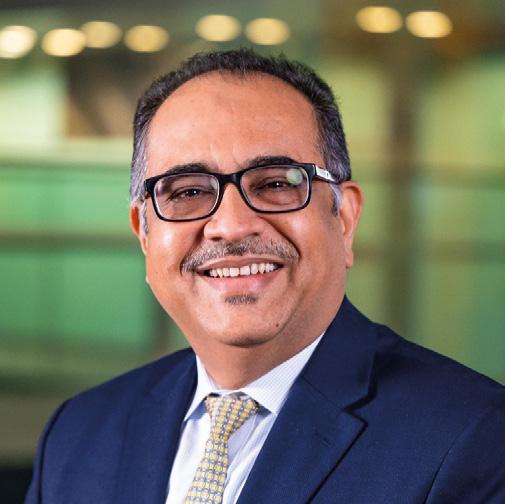
The pandemic and the war in Ukraine have shifted attention to supply chain resilience, while the climate crisis has underlined the importance of sustainability. Growth in the use of SCF, and innovation with deeptier financing, demonstrate that not only are companies intensely focused on the resilience and sustainability of suppliers, but treasury is now at the heart of these efforts. Supply chains are the new frontier for treasurers.
Useful links:
World Supply Chain Finance Report: bcrpub.com/publications/world-supplychain-finance-report-2022
World Economic Forum: www.weforum.org/agenda/2023/03/ treasurers-can-help-to-lower-emissions-andbuild-resilient-supply-chains-here-s-how
Puma Forever Better Vendor Financing Programme: annual-report.puma.com/2020/en/combinedmanagement-report/sourcing.html

treasurers.org/thetreasurer ISSUE 2 2023 11
Gavin Hinks is a freelance business journalist
Source: Windesheim
Supplier Buyer
Financier
1. Supplier sends goods and invoice
2.Buyer approvesinvoiceandsendsitto financier asks3.Supplierdirectly forpayment
4.Financierpayssupplier
5.Buyerpaysonoriginaldateorlater
BUILD THE COMPETENCIES YOUR TEAM NEEDS
Empower your team with the skills and knowledge required to master treasury, cash and liquidity management and boost their performance.
Our professional qualifications are delivered online and allow your team to develop the strong competencies needed to excel at work.
Your team will also walk away with a qualification that demonstrates the highest standards of professionalism.

Ensure your team meets the needs of your organisation. Find the qualification that is right for them at: learning.treasurers.org/pathway
CATERING TO ALL LEVELS AND WITH FAST TRACKS AVAILABLE
Our qualifications are built to support learners at every level of their career. Exemptions are available for qualified accountants and those with relevant academic or work experience. Learn more at: learning.treasurers.org/qualifications/entry-routes
he importance of good mental health cannot be overstated. Last year, the Institute for Public Policy Research (IPPR) said six in 10 people in the UK who are not in work because of poor health suffer from a mental health issue.
Given that it has been a particularly tough three years for treasurers under pressure to protect the financial strength of their organisations, it is a timely moment to ask how treasury functions are looking after themselves.
Paul Wilde, treasurer of retail and commercial bank Shawbrook Bank, says that, by its nature, treasury is a function where mental health can be tested because of the heavy responsibility that goes with the job on issues such as maintaining liquidity.
“Ultimately, we’re the first line of defence when it comes to making sure that an organisation can pay its bills and that’s quite a heavy responsibility.
“The numbers are large in things like interest rate risk. If you make an error, it results in a big number. That focuses people’s minds and does create an element of stress with the role,” he says.
STRESS TEST: GETTING MENTAL HEALTH RIGHT T

With that in mind, Wilde says that, when recruiting, he screens candidates for resilience. “In an interview, I’ll be asking about foreign exchange or interest rate risk. Some people find it OK, but for others it can be difficult for them to sleep at night.
“So, I ask: ‘Make sure you want to do this, as it’s not going be a job for you if it’s one that makes it difficult to cope day to day’,” he says.
Wilde says he can draw on broad support from the bank in the form of designated mental
Given the demands and responsibilities many treasurers are facing, creating a culture that promotes mental wellbeing is key to ensuring your team thrives, say experts
Shutterstock / pogonici LONG VIEW treasurers.org/thetreasurer ISSUE 2 2023 13
CULTURE
Zoe Sinclair, who owns Employees Matter and co-founded This Can Happen – an organisation seeking to improve workplace mental health – recommends treasurers create a culture within their teams “that is kind to mental wellbeing and that talks about mental wellbeing”.

She says: “Treasury leaders should encourage self-awareness in their team, where perhaps staff members create a checklist of how they’re doing every month, on areas such as whether they sleeping well or taking all their holiday.”
In meetings, she suggests asking staff how they are, perhaps by asking how they would rate themselves. “That manager has then clocked that he or she was a five out of 10, so maybe call later in the week or send an email to follow up to see if they were doing any better. It would make a huge amount of difference to that individual,” says Sinclair.
A short monthly catch-up is also recommended, whether it’s virtual or in person, which not everyone will want to attend. Sinclair says: “Sometimes, it’s the people who don’t turn up that you’ve got to be more worried about.”
As part of a caring culture, treasury leaders have to be fully aware of what resources their organisation has to address mental health issues, such as access to sleep apps, and to psychologists and therapists if they’re needed.
“How can the team be expected to know what the resources are if the treasury leader doesn’t even know?” says Sinclair. “Some leaders will send a monthly email to their team with any articles of interest that they have seen or around any aspects of wellbeing.
“When that email arrives in a staff member’s inbox, they will know their leader is trying to create a team that can talk about these things, and is trying to get the balance right in people’s lives and understanding where that might not be happening,” she adds.
health first aid, health support lines, and specific resources on its Slack channel and intranet.
Pandemic support
For many treasury functions, the pressures brought on by COVID-19 tested them to the limit. Take the engineering firm that recently became Parker Meggitt after being taken over by Parker-Hannifin Corporation.
Peter Makepeace, group treasury manager of Meggitt, joined the firm in 2019 along with group treasurer Linda Williams, and was playing a key role in transferring ownership and knowledge of the function to a new head office when the pandemic struck.
“Meggitt was massively hit by COVID. We had to quickly move from a period of revenue growth across the group to shoring up the company’s liquidity, tightly controlling costs, micro-forecasting operations and tapping into government support schemes,” he says.
Makepeace says that, fortunately, a solid governance structure and support from the senior management team – along with tight risk management policies – ensured the firm came through the storm, but it forced a reflection on how much stress their department had been under. “It could have been very stressful and more mentally disturbing,” he says.
Meggitt had a network of mental health first aiders in place on its sites, as well as running a series of week-long events that looked at issues such as suicide prevention, as well as an employee resource group on mental health, of which Makepeace is a member. “It can be a really good sounding board and gives help on the signs of mental health issues to look out for,” he says.
“That also links in with my view of the treasury function being at the centre of the organisation, a place from which to see everything that’s going on and to interact with all our people.”
Another implication of COVID-19 has been how it isolated people in ways they weren’t previously, and this can be a particular challenge for treasury, which Makepeace says can be a very insular place to work.
“With good systems in place, treasury work was well placed for operating remotely and there have been times in the past couple of years where I may go a week or two without actually seeing one of my colleagues face to face,” he says.
“There were times during lockdown where I could lock myself away and, while
LONG VIEW
14 ISSUE 2 2023 treasurers.org/thetreasurer
efficiently getting much work done, I would find myself falling into a rabbit hole of near depression quite easily, just by not being around other people.
“I’ve made efforts to break that. I’m now making the effort on video calls to sometimes converse about things other than work, as you would when spending time around others,” he says.
“I think people collaborate better and produce better outcomes the more talking occurs, whether that’s within the treasury function or across business functions. While it’s not always face-to-face contact, talking is easier face to

Useful links
This Can Happen Global: thiscanhappenglobal.com
Employees Matter: employeesmatter.co.uk
Mates in Mind: matesinmind.org
face than down a phone line, or across a video call,” he adds.
Mind construction
Some sectors are known to have a history of mental health issues. Elina Beale, treasurer of Tideway, the company delivering the Thames Tideway tunnel, says that, as a construction firm, it is “aware of the mental health issues within the construction industry, especially higher suicide rates”.
“It is one of the riskiest industries in this respect, with construction workers working away from home for long hours without their
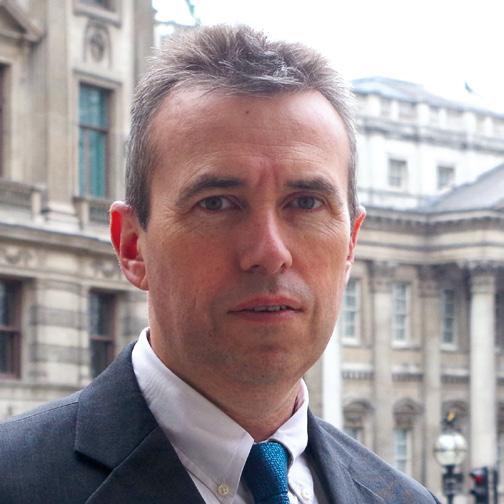
treasurers.org/thetreasurer ISSUE 2 2023 15
LONG VIEW
“
ULTIMATELY, WE’RE THE FIRST LINE OF DEFENCE WHEN IT COMES TO MAKING SURE THAT AN ORGANISATION CAN PAY ITS BILLS, AND THAT’S QUITE A HEAVY RESPONSIBILITY”
PAUL WILDE, SHAWBROOK BANK
Shutterstock /
pogonici
support networks,” she says. “Just the fact we work in this industry means that mental health has been quite important to us as an organisation, right from the very start.”
On top of that, the tunnel is heading towards completion, and the organisation has been changing. “This has been a huge source of uncertainty for our employees, which, as an organisation, we have had to manage,” she says.
Beale, who has trained to be a mental health first aider, says that the firm has put together a package of measures to address mental health, including work with the charity Mates in Mind.
There is great focus on health and wellbeing in the company: access to regular exercise classes, guidance on sleep, nutrition and stress management, other ongoing initiatives to allow staff to work on their personal and professional development and feel part of a supportive, diverse and inclusive organisation – a holistic approach to the issue.
Overcoming stigma
But part of the problem is that there is still a considerable amount of stigma attached to mental health issues – especially in regard to treasury functions, says Alex Hyde, a consultant at BIE Executive, who has worked with some of the UK’s best-known businesses

to appoint treasurers into leadership roles. Hyde, who struggled through a bout of severe depression after losing his wife to cancer, says treasurers may find it difficult to admit if their mental health might be at risk.

“They are understandably less likely to admit to struggling, as their role is to manage significant risk on behalf of the organisation and admitting to poor mental health could lead to them being perceived as the source of risk, rather than the manager of it. They are also likely to be anxious about speaking out because of the perception of their competence externally if they are managing multi-billionpound deals while experiencing mental health problems,” he says.
“While there has been a lot more conversation about mental health in the past five to 10 years, and it is now less stigmatised, it’s still incredibly difficult for people to talk about it,” he adds.
Hyde says that, after sharing his experiences, treasurers responded positively, but admitted their own concerns about revealing problems. “They said: ‘That was amazing. It was really great that somebody did that, but I could never do that, even though I felt that way, because it would be a disaster for my career’,” he says.
“If people are feeling that way, it’s really important that they tell somebody so that
LONG VIEW 16 ISSUE 2 2023 treasurers.org/thetreasurer “
ADMITTING TO POOR MENTAL HEALTH COULD LEAD TO THEM BEING PERCEIVED AS THE SOURCE OF RISK, RATHER THAN THE MANAGER OF IT”
ALEX HYDE, BIE EXECUTIVE “
ACTUALLY
Visit treasurers.org/hub/ wellbeing for more information on mental health and wellbeing
THERE HAVE BEEN TIMES IN THE PAST COUPLE OF YEARS WHERE I MAY GO A WEEK OR TWO WITHOUT
SEEING ONE OF MY COLLEAGUES FACE TO FACE” PETER MAKEPEACE, MEGGITT
they can do something about it – because the problem with mental health is that it can be very difficult to know if someone’s struggling. The turning point for me was talking to my partner about how I was feeling.”
Hyde says that a powerful way of overcoming the challenge is developing a culture of honesty around the issue, and of recognition that it is an ongoing challenge; achieving mental wellbeing is a work in progress.
“We tend to talk about people when they’re in a mental health crisis, but we should be thinking about what we can do to manage the mental health of people so they can thrive,” he says. “Rather than creating environments in which people feel stressed, anxious and under pressure to perform, we should look to build cultures that give people the mental freedom to do great work.
“When I came out of my mental health crisis, I took a totally different look at mental wellbeing. It goes up and down depending on circumstances that are playing out in your life, be they work, home, or both. As a result, leaders who think about how they can create positive environments for their people at work are far more likely to be rewarded by high performance.”
Flexible problems
Shawbrook Bank’s Wilde says it can be difficult detecting when someone may be at risk. “Pre-

COVID, you would be seeing people in the office, several days a week, so could get at least a sense of how someone was coping – but with flexible working, you’re not in contact as much; it’s a bit more difficult,” he says.

He also suggests monitoring can feel intrusive. So he argues for striking the right balance through team members all keeping an eye out for each other and identifying concerns in a compassionate and supportive way.
An approach also requires recognising the limit of what a team member’s reasonable workload should be. “I have to think more holistically around this, generally,” he says.
BIE Executive’s Hyde says people work better if they are less stressed and worried. He says: “If you can create an environment where people are freer from those things, they are better able to use them creatively to do their jobs.
“So, rather than giving your best person 10 projects and running them into the ground, give them six. Give them the time to do them really well.”

treasurers.org/thetreasurer ISSUE 2 2023 17
LONG VIEW
Lawrie
Holmes is a freelance business and financial journalist
“
[WE ARE] AWARE OF THE MENTAL HEALTH ISSUES WITHIN THE CONSTRUCTION INDUSTRY, ESPECIALLY HIGHER SUICIDE RATES”
ELINA BEALE, TIDEWAY
Shutterstock / pogonici
CROSSROADS FOR NEW PAYMENT MESSAGE SYSTEM
are also due to migrate to ISO 20022 in the next few years.
In addition to the UK, many other major jurisdictions are scheduled to implement ISO 20022 ahead of November 2025, when SWIFT is due to retire its existing MT message standard for payments.
According to the Bank of England, there are a number of advantages to the new standard:
Flexibility: ISO 20022 can adapt more easily than current messaging standards. It is more responsive to changes in the economy, emerging technologies and innovation.
Harmonisation: More than 70 countries have already adopted ISO 20022, so messages will be harmonised with payment systems around the world.
Compliance and regulation: Richer data will make it easier for businesses to detect fraud and help target financial crime.
n a single weekend in March 2023, and with minimal fanfare, the European Central Bank and SWIFT migrated their payment systems to a new messaging system, ISO 20022. The new standard facilitates the sending of enhanced data in a richer, more structured format than existing Message Type (MT) standards. It is an open international standard, which has the potential to create a single common language for most payments globally. The difference between the new and existing standards has been likened to mailing a postcard and sending an email with 20,000 attachments.
At present, the fragmentation and mixed use of payment messaging standards is a major friction in cross-border payments. The ISO 20022 format is being introduced to address these inefficiencies.
Following the successful European switch, CHAPS, the Bank of England’s Real Time Gross Settlement System (RTGS), will migrate to the ISO 20022 standard on 19 June 2023. As part of Pay.UK’s New Payments Architecture programme, retail interbank payments in the UK
Resilience: ISO 20022 will be used across many payment systems. This improves resilience by allowing rerouting of messages, which reduces the impact of outages on users.
Straight-through processing: Less need for banks to make manual interventions. Potentially fewer delays for the end customer.
Competition and innovation: More flexibility means more competition and innovation in the financial sector. Better data may lead to product innovation.
Enriched data: More data can be carried. It enables more detailed and better structured reference information.
Analytics: Enriched data will improve analytics. More efficient data collection may improve the decision-making.
“We are already making tangible progress towards enhancing cross-border payments,” Victoria Cleland, executive director for banking, payments and innovation at the Bank of England, said at a recent conference. “We are currently undertaking a transformational RTGS Renewal Programme to deliver a range of new features and capabilities for payments. This will include several features highlighted in the priority focus areas – such as the adoption of ISO
O
LONG VIEW 18 ISSUE 2 2023 treasurers.org/thetreasurer
The adoption of a new messaging standard could create many opportunities for corporates, but the move will not be without its challenges
20022 this summer, reducing barriers to access RTGS, and enhancing user functionality.”
However, the continuing progress towards harmonisation is not without its challenges. A recent report from the Bank of International Settlements said that “while a common adoption of ISO 20022 presents the potential for enhanced cross-border payments, variability in the ways in which the standard is deployed and used across the globe risks undercutting some of its benefits”. The report, ISO 20022 harmonisation requirements for enhancing cross-border payments, said that many of the inefficiencies with cross-border payments that the financial industry and its customers currently face are caused by misaligned message flows and inconsistent data usage along the end-to-end payment chain.
So, while ISO 20022 provides a common base for more interoperable exchange of cross-border payment messages, how the standard is used in practice can vary quite considerably. This means that frictions in the processing of cross-border payments could continue to persist even as ISO 20022 is adopted.
The slow adoption of ISO 20022 messages by end customers, such as corporations, also imposes a further challenge for harmonisation. “Jurisdictions, payment system operators and participants should play a key role in encouraging adoption by end users,” the consultative report from the BIS’ Committee on Payments and Market Infrastructures said.
Naresh Aggarwal, associate director of the ACT’s Policy and Technical team, pointed to the competitive advantages that corporates could gain from adopting the standards in their own payment systems. “You don’t want to be the one that isn’t using it,” he told the recent ACT Cash Management Conference. “The world has moved on, but [cross-border] payments are only just moving on.”
Elizabeth Leather, Bank of England RTGS policy implementation manager, who also spoke at the conference, added that there would be considerable data advantages, such as improved cash forecasting: “You can track your payments, you will know your expectation, you will know where your money is.” She added that the new standard would allow greater opportunities to automate invoice processing and automatic settlements, and suggested that corporate treasurers should be talking with their enterprise resource planning (ERP) providers and relationship banks to realise these benefits.
FIVE PAYMENTS TRENDS TO KEEP YOUR EYE ON IN 2023
1 Digital transformation continues full speed ahead Digital transformation is no longer ‘a nice to have’, but rather a strategic priority industry-wide. Expect organisations to continue updating technology throughout 2023 to gain efficiencies and compete more effectively.
2 The customer reigns supreme
Fast, frictionless payments improve the customer experience and add stickiness to the relationship. Streamlining the payments process will help drive business growth in 2023 and beyond.
3 Payments data enhances benefits of focus on fraud and anti-money laundering
The convergence of fraud and anti-money laundering (FRAML) is poised to bring greater focus on payments data in 2023. Sharing payments intelligence across business functions provides a more complete picture of the customer for better risk assessment, faster onboarding and more assured compliance. Linking payments functionality with an organisation’s FRAML framework and the enriched message formats of ISO 20022 will deliver even greater efficiencies.
4 Adoption of end-to-end payments platforms makes significant headway

As software and services are increasingly incorporated into payments platforms to provide a more turnkey model, the diversity of payments platforms will continue to grow. Organisations that take steps to integrate their payments platforms, software and services, for an end-to-end solution, stand to benefit from faster transaction processing, ongoing productivity gains, lower fees, and a better overall client experience.
5 Failed payments remain top of mind
The estimated $118.5bn lost to failed payments globally in 2020 was a wake-up call. Failed payments take too big a bite of the global economy to be sidelined as the ‘cost of doing business’. Instead, they represent a true business cost – both in terms of lost revenue and lost customers. Reducing failed payments is an ongoing priority for organisations in 2023. With some organisations sending more than 1,000 payments per minute, even a small number of failed payments adds up quickly in bank fees and time spent identifying and fixing errors.
Source: LexisNexis
Philip Smith is editor of The Treasurer
Source: LexisNexis
LONG VIEW treasurers.org/thetreasurer ISSUE 2 2023 19
Naresh Aggarwal, associate director of the ACT’s Policy and Technical team, publishes a regular payments update at treasurers.org/hub/blog
ANSWERING BOARDROOM QUESTIONS
Identify your risk appetite: as a business, a certain amount of volatility will be acceptable, but is everyone clear on that? Identify what those thresholds are for all of the risks you manage and make sure they are approved at the highest level.
Managing financial risk in times of crisis is quickly becoming the new norm following the financial crisis, Brexit, the pandemic, and recent events in the banking industry. FX rates and commodity prices continue to be highly volatile, and interest rates have been increasing over recent times.

As a result, the important work that the corporate treasury function performs in protecting, managing and ensuring access to the company’s cash is high on the boardroom agenda. Here are some of the questions the board is asking:
• Which financial institutions do we have exposure to and how are we exposed to them?
• How do we measure and manage counterparty risks?
• Are we managing our counterparty risk appropriately?
• Do we have the right banking partners?
• Do we have adequate liquidity to meet the funding needs of our business?
• What impact will volatility have on our FX and interest rate hedging strategy?
• How might the situation impact the debt markets and bank appetite to lend?
• Will we be able to access our existing credit lines?
So, this is an ideal time to revisit how you are managing financial risk. I would recommend looking at the following areas now: Understand the exposure: be very clear on what your exposures are and how they affect the business, such as the impact on financial statements, cashflows and covenants. Businesses are rapidly changing and, as a result, so are the financial risks. Exposures need to be constantly assessed and not a ‘one point in time’ assessment –assumptions made in the past could be out of date.
Have a clear risk strategy: protecting the business through volatile times and uncertainty requires clearly articulated strategies and frameworks. These include foreign exchange, interest rate and commodity price risks. Never forget about the liquidity and counterparty risks, but, increasingly, you need to also consider wider impacts and priorities, such as environmental, social and governance or geopolitical considerations. Strategies may need to evolve to identify and tackle new risks and opportunities.
Report on the exposure: real-time reporting on each exposure is heightened during times of crisis. The technology needs to be there to perform this and be flexible enough that different views can be assessed and reported to key internal and external stakeholders for rapid decision-making.
In the immediate future, I would recommend taking the following actions:
Counterparty risk: review the number and financial strength of your financial institution partners; evaluate counterparty risk, concentration risk, and regulatory risk, and consider whether changes are required.
Protect your cash: evaluate your current and prospective cash needs and cash investment strategies, with an eye towards achieving the important objectives of preserving principal, and meeting short-term funding needs.
Ensure access to liquidity: look at sources of liquidity, such as cash on hand, working capital and lines of credit, and assess their adequacy given various potential financial market, supply chain, vendor or company-specific conditions.
Manage financial risk: confirm if credit lines offered by financing partners remain available to draw or whether access (or terms) are changing.
It is important not to do this in isolation. You should liaise with the business – for example, local finance teams, procurement, finance committees and the board – to get their perspective. Above all, this needs to be a collaborative approach.
20 ISSUE 2 2023 treasurers.org/thetreasurer
At a time of crisis, managing financial risk moves to the top of the board’s agenda, but what steps should you be taking now to protect your cash? Robert Waddington has the answers
Robert Waddington is a partner in PwC’s UK Corporate Treasury and Commodity Group
LONG VIEW
“ NEVER FORGET ABOUT THE LIQUIDITY AND COUNTERPARTY RISKS, BUT, INCREASINGLY, YOU NEED TO ALSO CONSIDER WIDER IMPACTS AND PRIORITIES”
isk management has always been a key part of the treasurer’s job description, but at times of crisis it becomes fundamental.
So, as I begin my term of office as president of the ACT, I am encouraging treasurers to look at their skill set and identify any potential gaps in their armoury.
It has been a tense few weeks for the global financial system, with recent bank collapses stoking fears of another financial crisis. It might be too early to say where this will end, but a key question that will be answered is whether or not we have learned the lessons from the previous financial crisis.
Irrespective of the answer, this is a good time for treasurers to look at the governance within their own businesses, the risk portfolios, and counterparty risks. In any crisis, whether it’s a banking crisis, pandemic or energy crisis, we must all look at the broader context and work out where we are as a business. That could be within the enterprise itself or the wider business ecosystem – sector, industry, and even country level.
ENGAGEMENT
Then we need to translate these wider business risks into our own areas. Are we reflecting these risks; are we engaging with the business; are we moving out of our own silos? To do so, we need to engage with the whole business. This is not just during times of crisis – we should be acting as business partners and talking with other functions throughout the business during the good, as well as the difficult, times.
There are, of course, other long-term risks we need to take account of, notably the whole area of sustainability. This will require a commitment to updating skills so that we are ready to engage with the business at this new level. It will also require us to build the right teams, reduce bias, and create diversity of skill sets and of thought.
There is no doubt this will continue to be a challenge for the treasury profession – is sustainability treated as a niche topic, or is it truly embedded into treasury thinking and processes? That is not to say that corporate treasurers should be doing the work of the ESG team – far from it – though the eagleeyed will have spotted that I am now head of sustainability at PageGroup, having previously been its group treasurer.

MANAGING RISK IN TIMES OF CRISIS
DEEP DIVE
However, it is clear that sustainability can cut across multiple operations and functions. It is through this lens that sustainability affords us an opportunity to review our finance providers: are they a responsible employer; what is their commitment to diversity; what is their environmental impact? For example, have you taken a deep dive into your investment portfolio and asked whether it matches your organisation’s sustainability ambitions?
We also need to acknowledge that green and sustainable financing is no longer a niche product; it is fast becoming the mainstream. In this respect, treasurers need to understand that, as a bank’s customer, their company’s environmental impact affects the bank’s carbon emissions reporting and, therefore, will affect whether a bank can offer you financing and even transactional banking.
To tackle these emerging risks, and the risk of being left behind, treasurers need to ensure that, individually, their skills are up to date. The ACT provides a wide range of CPD courses and qualifications, as well as plenty of networking opportunities where you can share best practice, so please take advantage of these resources and get match fit. That way, we will all be able to fully support our organisations during these testing times.
Find out more about ACT courses and qualifications at: https://learning.treasurers.org/
R
Treasury skills come to the fore when faced with financial uncertainty, says Joanna Bonnett
Joanna Bonnett is head of sustainability at PageGroup and president of the ACT
“
treasurers.org/thetreasurer ISSUE 2 2023 21 LONG VIEW
IN ANY CRISIS, WE MUST ALL LOOK AT THE BROADER CONTEXT AND WORK OUT WHERE WE ARE AS A BUSINESS”
REPEAT OF 2008? DON’T BANK ON IT
This highlights the second, most important, point. While it is impossible to say for sure how this whole episode will end, we can say with a high degree of confidence that global central banks and regulators will not repeat the catastrophic decision in September 2008 to allow Lehman Brothers-style bankruptcy without adequately protecting counterparties from sudden massive losses. That fateful error turned a nasty recession into needless global financial crisis.
But the legacy of Lehman is that policy-makers are now much quicker to find the resolve and political will to do what is necessary to preserve the system in case of individual failures.
MORAL HAZARD







Does that worsen moral hazard in the financial system? Probably, yes, but only at the margin. But in real life you have to pick your poison. Remember that owners and – most likely –managers of the failing institutions will still have to pay a steep price for their errors.
Following two headline-grabbing bank failures in the US, a major sell-off in global bank stocks, and the forced merger of Switzerland’s biggest two banks in order to save one of them, many investors are seriously concerned that the western world is heading for another 2008-style financial crisis.
But is this view justified? For two important reasons, it is not.
First, in the wake of the 2008 crisis, regulators on both sides of the Atlantic dramatically stepped up the oversight of major banks. In Europe, the tighter regulations apply to all banks. Such rules mean that, in the UK, for instance, banks hold 3.5 times more top-grade capital today than in 2007.


The situation in the US, with its thousands of smaller regional banks, is different. Only large US banks face the tightest regulations, while smaller, ‘non-systemically’ important banks face less scrutiny. However, in the end, it was the decision by US authorities to guarantee all deposits at the two failed banks that really counts. It demonstrates that they had no inhibitions about stepping in to stop the rot before it could take hold. Ditto the Swiss authorities’ decision to cover some of the potential losses in the UBS merger with Credit Suisse.

Does it mean the western world is in the clear? Not fully. Keep in mind, the unfolding problems are the result of the global monetary squeeze that started in late-2021.
But the likelihood now is that banks will hoard liquidity as they – and their regulators – try to fully understand their own risk positions and those of their immediate counterparts.

This will constrict global credit flows and reduce the need for central banks to go much further with monetary policy tightening. Major central banks, including the US Fed, the ECB and the BoE, may now pause their rate-hike cycles or stop sooner than previously envisaged.
As long as financial markets and banks stay assured that authorities will act as a backstop for the system, most of the adjustment to the banking sector wobbles will come via a more moderate expected pace of monetary tightening – thereby mitigating any major hit to the real economy.

Nevertheless, at least in the near term, the economic risks to a European recovery following the winter gas shock and a mild US recession are no longer tilted to the upside.

22 ISSUE 2 2023 treasurers.org/thetreasurer
ANALYSIS
“ POLICY-MAKERS ARE NOW MUCH QUICKER TO FIND THE RESOLVE AND POLITICAL WILL TO DO WHAT IS NECESSARY TO PRESERVE THE SYSTEM...”
Kallum Pickering is senior economist at Berenberg Bank
Fears that we could be witnessing a repeat of the crisis that hit the financial sector 15 years ago could be wide of the mark, says Kallum Pickering
Shutterstock / Vector
Pro
Stock
FINANCE LEADERS SHIFT FOCUS TO PRODUCT AND SERVICE PRICING
McKinsey survey reveals how CFOs have reshuffled priorities as they grapple with financial risks at the expense of performance management and long-term strategy
According to the survey, finance leaders have been forced to pivot their priorities in the face of an economic slowdown, sharpening their focus on inflation, interest rates and supply chain disruptions.
But the most radical shifting has been towards a focus on pricing of the business’ products and services. A year ago, less than 10% said they spent most of their time on pricing, now more than 40% say this is the case.
This has left them with less time to focus on building capabilities and organisational growth. A year ago, around 55% said they spent most of their time on performance management while around a half were focused on strategic leadership. Now those figures stand at less than 30% each.
This switch in priorities is, at times, putting them out of kilter with the strategic ambitions of their organisations. Respondents report that while their organisations prioritise strategic planning, for example, they are personally more concerned with improving the management of financial risk, liquidity, and resource allocation. The results suggest that many CFOs are prioritising the areas that they can affect directly. While proper strategic planning is important for the entire organisation to manage uncertainty, financial leaders may not see it as a top priority as they very often don’t solely lead that process. As for the misalignment on budgeting and forecasting, CFOs may view them as areas that are well under control and don’t need as much of their focus.
www.treasurers.org/thetreasurer June/July 2018 The Treasurer 23 OPEN BANKING
IN DETAIL:
treasurers.org/thetreasurer ISSUE 2 2023 23
Source: McKinsey Global Survey on the role of the CFO
(https://mck.co/3mHRolz)
CFOs' areas of time spent during previous 12 months, % of respondents 0 10 20 30 40 50 60 Pricing of company's products and services Risk management Cost and productivity management across organisation Performance management Resource allocation Strategic leadership Organisational transformation within finance organisation or of broader organisation Finance capability management Support of digital capabilities and advanced analytics Management of environmental, social, and governance programmes M&A Management of activist investors DECREASED/NO CHANGE INCREASED 2021 2022 $£€
A trusted partner for the long term
With a presence in London since 1918 and rooted in the stability of Japan and growth of Asia, SMBC Group reaches out around the world to provide the advice, connections and support that create value. Our clients choose us because we offer local knowledge and global expertise that span a wide range of financial services.
www.smbcgroup.com/emea

SMBC Bank International plc (SMBC BI) is authorised by the Prudential Regulation Authority and regulated by the Financial Conduct Authority and the Prudential Regulation Authority.
Treasury, but not as we know it
The recent ACT Treasury Forum hosted a discussion on future trends. Here, the four panellists swap notes on what lies ahead as technology offers wide-reaching possibilities

treasurers.org/thetreasurer ISSUE 2 2023 25
FUTURE TRENDS Shutterstock / kitti Suwanekkasit
FUTURE TRENDS
Paolo Sala, group treasurer, BAI
Communications
The role of corporate treasurers has significantly changed over time as a result of super-fast technological developments and the ever-changing underlying macro and micro landscape in which we operate. Here’s a quick reminder of some macro highlights over the past couple of decades:
2000: Dotcom boom and bust
2008: The global financial crisis with government interventions to avoid the collapse of the financial systems. The consequent financial crises in Portugal, Italy, Ireland, Greece and Spain in the following years
2016: Brexit referendum
2020: COVID-19
2022: Russian invasion of Ukraine
2023: Threat of global recession amid double digit inflation
Ongoing: The new age of sustainability and ESG in response to climate and social crises.
The ability of corporate treasurers to anticipate, manage and mitigate the impacts of economic and political developments, as well as to be ready to quickly and flexibly respond to the unplanned, will always be key factor for the success of the organisations for which we work.
Likewise, the ability to select relevant and resilient technological counterparties that can help the job of the treasurer are, more than ever, key recipes for success. This is particularly true because technology is the enabler that allows treasurers to deliver more and better with fewer resources.
With the fast-moving pace in this sector, we have seen a lot of tech organisations come and go. Therefore, we need to make sure that the tech company we invest in today will be there in the near future to support our current needs as well as our future needs, which we know are going to be different.
Payment digitisation
If you work for an organisation that puts customers first, you will need to respond to ever-changing customer demands to be relevant today and tomorrow. One of the relatively recent megatrends we have seen is the digitisation of payments and receivables. Being able to engage with your customers globally through all channels – enabling a quick and frictionless check out in-person and/or online by offering them their preferred payment methods – is essential in modern economies. Paying your global suppliers – out of different jurisdictions – with their required payment methods, complying with local regulatory requirements and with the required internal controls,
workflow and encryption, could be a challenge as financial institutions are lagging behind fintech companies that have been able to take advantage of opportunities to provide better services.

Here is where the treasurer can, and will, play a key role in the future because of our genuine desire to drive automation with best-in-class treasury solutions, and to respond quickly to the needs of customers and suppliers. This must take into consideration the impacts of treasury projects in terms of internal IT infrastructure, financial and legal frameworks, back-office processes, internal controls, tax, ESG aspects and, last but not least, costs for our organisations. The solution must be a win-win for all parties involved. This is stretching far beyond the traditional treasury remit as it requires a higher level of technical understanding in addition to a much higher level of internal engagement and cross-functional collaboration.
So, while on one hand the role of corporate treasurers will carry managing micro- and macro-economic, financial and non-financial risks, on the other, it will be fundamental to keep a close eye on the technological developments to drive simplifications with cross-functional win-win opportunities for the collective and best treasury solutions.

26 ISSUE 2 2023 treasurers.org/thetreasurer
Paolo Sala
Jack Swait, 4Payments Advisory, Global Payments Solutions, HSBC

As corporate treasurers pursue transformation projects, they look to their partners, including cash management and technology providers, to support them in navigating the journey. Establishing centralised real-time models with accelerated movement of funds remains high on corporates’ agenda. Many treasurers are seeking the ability to consume large volumes of data from their cash management providers in real time and all on globally deployed technology platforms, as well as with streamlined processes and fewer accounts.
Banks have responded to this demand with a range of solutions. Real-time payments, APIs and virtual accounts provide more arrows in a treasurer’s already bulging quiver to accelerate and streamline treasury processes.
This trend is especially evident in light of the proliferation of new business models requiring digital solutions, including real-time receipt of account information, domestic and cross-border disbursement, and automated receivables reconciliation.
Customer journeys
The knock-on effects of this development are evident in the diversification of
collection methods. The race has now begun among corporates to offer their customers the experience they increasingly expect. The most innovative corporates are aware that it is a material competitive advantage that could be critical to survival. The need to offer customers the payment journey they demand is made more challenging since new payment methods are not replacing legacy ones but joining them on the list that discerning consumers expect. This is creating challenges for cash management and treasury teams not only to integrate diverse collection methods into their front-end point of sale (POS) and e-commerce checkouts but also to reconcile increasingly eclectic reporting that often accompanies each receivables instrument.
While corporates continue to redefine the art of the possible by employing the latest solutions in ever more sophisticated ways, new possibilities continue to emerge on the horizon with data, distributed ledger technology (DLT) and APIs all showing promise.
Central bank digital currencies
Increasingly, central banks are exploring the idea of their own digital currency, a CBDC that could ensure safety, robustness and efficiency of
payments for developed nations while promoting financial inclusion in emerging economies. CBDCs could help to spur further economic growth by making payments and settlements more efficient and cheaper. As one of the world’s largest financial institutions, with deep experience of cross-border payments and foreign exchange markets, HSBC will continue to be involved in discussing and developing CBDCs. We are already working in partnership with many central banks, including those in the UK, France, Canada, Singapore, mainland China, Hong Kong, Thailand and the UAE, as they each consider how CBDCs can best work for them.
This is a rapidly evolving space in which it is important to stay connected with developments. It’s therefore important to engage with banking and financial partners, other functions within the company, including those with direct customer contact, and treasury peers.

treasurers.org/thetreasurer ISSUE 2 2023 27
FUTURE TRENDS
Jack Swait
“Treasurers have a genuine desire to drive automation with best-in-class treasury solutions”
FUTURE TRENDS
Ikaros Matsoukas, director, treasury advisory, Deloitte
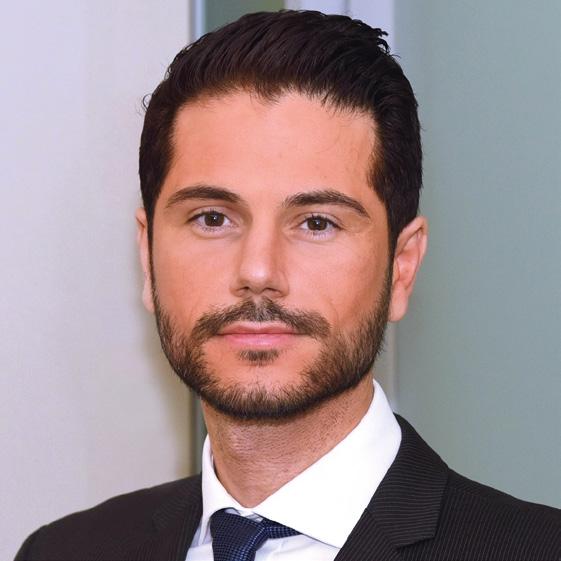
The combination of the new macro environment with a number of technologies becoming more available or more mature has created a unique situation. We are seeing new ideas piquing the interest of corporate treasurers together with more established concepts re-emerging as post-COVID trends.
We see new business models, the exponential growth of e-commerce and the direct-to-consumer trend, supported by advances in payments technology (APIs, digital payments) and the establishment of industry standards and regulations (Open Banking, PSD2, ISO 20022). We also see financial risk management re-emerging with more and more companies exploring – and in fact prioritising – the review of their currency or interest rate risk management policies and seeking advice on how these should look like in a more volatile economic landscape.
It is worth noting that all of the above have sustained a more foundational trend that we have been experiencing: we see technology stepping in at the forefront, becoming the spearhead of treasury transformation.

Ten or 15 years ago, at the start of my career in finance, technology was more of an afterthought, something that we’d come to implement after all new business processes and policies had been agreed and signedoff. What we see now is technology being an integral part of this discussion. The reason is that more organisations are starting to realise that it is technology that offers those building blocks to design and execute their strategies, and help them stay competitive.
The 2022 shocks, with the increased geopolitical risk adding to existing supply chain challenges and market
volatility, showed us again the importance of being resilient. Although resilience is not a new imperative for business, what has now changed is the speed and the severity with which these new challenges become the new paradigm. On a more positive note – at least for the business – corporates have access to a variety of tools and to vast amounts of data to help them be more prepared and resilient.
As a result of that, we see cash and liquidity forecasting processes being revisited, and a more dynamic, scenario-based planning approach emerging that leverages AI and machinelearning tools.
Real-time treasury?
Some real-time processes and tools have been available to treasurers for a long time. Again, I remember 10 or 15 years ago we were being asked to connect realtime data feeds (Bloomberg) to treasury management systems. Our response was very similar to our response now: “Do you really need it? Would a real-time GBP/USD feed bring any value, especially considering the high cost and technical debt?”
Of course, the current ecosystem is more mature in terms of supporting a real-time infrastructure, but we still encourage our clients to reflect on what would a move towards real time mean to them and to their working capital. Would it generate more value, decrease costs or meet any other business objective? The answer could be yes, if, for example, instant balance reporting is paramount to the business, but in other areas – such as payments – the answer might be that an in-time or on-time model is a wiser, more fit-for-purpose choice.
Looking ahead, we should expect to see greater disruption, and to come
across things we now don’t know that we don’t know.
Look at what 2022 brought to art. Text-to-image generators using AI such as DALL-E and MidJourney allowed everyone to create art not just without brush and paint, but even without any specialised software. Just with a text prompt. Now, if AI can do that to art –the human activity we considered perhaps to be the least susceptible to disruption – imagine what it can do to treasury and finance.
But we can see this with optimism: AI upended the ways of making art. It did not reduce the human need for artistic expression – if anything, it further enabled it. The same can happen to treasury – or the art of it: the need to manage liquidity in an efficient way, to safeguard our organisations from risk and so on, will still be there. It will be the ways of performing these processes that will be disrupted.
28 ISSUE 2 2023 treasurers.org/thetreasurer
Ikaros Matsoukas
Arunav Das, head of liquidity product, Global Payments Solutions RFB, HSBC

The corporate treasury construct is evolving to support the transition from pre-pandemic ‘just-in-time’ to post-lockdown ‘just-in-case’ business models. The latter involves designing treasuries to accommodate reconfiguration of supply chains and distribution centres in a rapid, dynamic and digital way.
Such a shift of business models at short notice presents new challenges with liquidity and FX risk managements. In addition, the current interest rate environment has already posed interest rate risk management challenges on both sides of the balance sheet because of a trade-off between working capital financing costs and opportunity cost for foregoing investment of surplus cash.
Treasuries have invested in the automation agenda for more than three decades and the majority of
the investments made have been geared towards bringing operational efficiencies linked to Accounts Payable and Accounts Receivable centres. This is an important foundation for setting up a real-time digital treasury.
The journey for setting up a digital real-time treasury would involve:

• Consolidation of cash positions across bank accounts, currencies, entities in an automated way. This will bring greater visibility to cashflows
• Forecasting/projection of cashflows will be more accurate if the consolidation and aggregation stage not only provide the headline impact but also the ability to decompose the individual parts for scenario and impact assessments
• Decision support systems would need to be built on treasury systems to optimise the trade-offs between costs and returns through decision choices between credit vs cash payments;
individual vs bulk payments; instant vs deferred payments; self-funding vs lending/ financing;
and overnight vs term investments
Digital real-time treasury models with well-designed and integrated consolidation, forecasting and decision support systems would also be able to find new opportunities for creating efficiencies in the business through assessment of bank account structures, automated reconciliation, self-served queries, with better management of cashflows and credit decisions.
treasurers.org/thetreasurer ISSUE 2 2023 29
FUTURE TRENDS
Arunav Das
“Increased geopolitical risk added to existing supply chain challenges and market volatility, showed us again the importance of being resilient”
COMMUNITY ACTION
For Matt Cooper, Places for People (PfP) has a clear purpose – which is to use the strong foundations of its core affordable housing business along with its diverse homes-to-leisure Group companies to change lives and create positive outcomes for all its customers. As PfP’s tax and treasury director says: “As the UK’s leading social enterprise, we engage and utilise all parts of our group – which includes regeneration and development, property management, and an extensive footprint of leisure provision as well as the heart of our organisation, affordable housing – to create and support thriving
communities across the UK.” PfP can trace its roots back to 1965, when North British Housing Association took over housing stock from Preston council in North West England. Since then, the organisation has grown through building its own homes and merging with other associations, while at the same time increasing its breadth across complementary businesses including property management and managing leisure facilities for other local authorities.
“It is a whole-community approach but with affordable housing right at our core. Managing and developing social housing, but looking right across our organisation, and building partnerships,
we have a model that aims to be more than the sum of our parts,” Cooper explains. “Our purpose is to enhance the communities that we serve.”
In the last financial year, the group delivered 1,775 new homes, owning and managing 231,000 properties with 500,000 residential customers and saw 1.9m monthly visits to its Places Leisure centres. It invested £947,000 in 93 local and national community projects and £133.1m in home improvements, and plans to create 10,000 homes over the next 10 years as part of a framework agreement with Countryside Properties plc. It has £5bn in fixed assets spread across England and Scotland.

“As a strategic partner of [government agency] Homes England, we have grants that we can deploy around the country, so we are not fixed to one location,” Cooper says. “We have that flexibility, and we can also learn different things from different local authorities and different geographies. It is a real advantage to have that breadth and national presence and of course, partnerships.”
New model
It is this attitude towards utilising the breadth of the group that Cooper is bringing to bear on how the organisation finances its schemes. The traditional financing model for housing associations has been based on raising finance secured against properties, but PfP has been in the forefront of moving this model towards unsecured, syndicated finance. Its efforts were recently recognised in the ACT’s Deals of the Year awards, where the group collected the award for loans above £750m and the overall Deal of the Year award after it negotiated an unsecured £900m revolving credit facility with its new and existing banking partners, a first in the sector.
“We had been keen to diversify the investor base, and we had issued a private placement in the US and done deals in Asia, Australia and Europe,” Cooper explains. “Then a few years ago, we began looking at our banking portfolio – most housing associations are banked with the traditional high
SOCIAL ENTERPRISE
30 ISSUE 2 2023 treasurers.org/thetreasurer
After completing an award-winning ‘first in sector’ RCF, Places for People tax and treasury director Matt Cooper explains how the social enterprise is moving away from the traditional financing model
street names, and most funding is secured, but we wanted to bring new banks into the sector.
“Some facilities were secured, some were unsecured, so we wanted to put in place a fully unsecured revolving credit facility, replicating how a normal corporate would have its arrangements.”
PfP’s approach was to arrange bilateral RCFs, moving the existing bank agreements towards unsecured facilities, bringing in new banks. “When this had reached a critical mass, the idea would be to turn it out into a single facility,” Cooper says, adding that although many of the banks were keen to be a part of the process because they wanted to be on the same terms as everyone else, it was felt that it made sense to bring in banks bilaterally if they were new to PfP.
The process had initially begun before COVID-19 struck but had to be paused until summer 2022. “We had trailed the syndicated RCF before then, so it was just a case of pulling everything together, and it was something that
we could do fairly quickly,” Cooper says. Operationally, it has also been an advantage to move away from a number of different facilities with different maturity dates into a single, three-year facility. There is the added benefit of being able to extend, bring in new banks and increase the size of the facility.

ESG at the core
The one new point was the introduction of environmental, social and governance metrics into the facility. But as one would expect with such a social enterprise, ESG is very much on PfP’s agenda. “ESG is at the core of what we do, it’s nothing new to us,” Cooper explains, having issued a use-of-proceeds sustainability bond in January 2022, which was raised for developing new housing and retrofitting existing properties.
“There is a lot of interest in the ESG linkage,” he says. “But we were keen not to do that on our bilateral facilities because then we would have had many potentially different metrics, but for the
A LANDMARK TRANSACTION
Places for People won the overall award at the recent ACT Deals of the Year awards for the refinancing of multiple facilities into a first for the social housing sector – a debut syndicated £900m fully unsecured ESG-linked RCF. The refinancing was launched on 22 July with a combination of both incumbent and new banks.
From the outset, Cooper and members of the treasury team (head of treasury Baljit Singh and treasury solicitor Abigail Wilson) worked with stakeholders delivering a successful outcome amid a turbulent macroeconomic and geopolitical backdrop. Despite the move to unsecured, the transaction was priced competitively and at an improved level compared with the existing weighted average margin. The transaction successfully completed on 14 October 2022.
In addition, and to work alongside its clear social housing goals, PfP agreed on three meaningful and stretching environmental and social KPIs aligned with four of the UN Sustainable Development Goals. These were documented in line with the LMA’s Sustainability-Linked Loan Principles with performance tied to upward and downward margin ratchets.
The facility represented a landmark transaction as the biggest syndicated RCF of any provider within the sector. Furthermore, PfP has set a clear framework for other social housing providers to obtain a similar facility, ensuring a simpler and cleaner structure for all stakeholders.
SOCIAL ENTERPRISE
new RCF, it would have been difficult not to have included ESG.”
The metrics cover areas such as energy efficiency and employment which are designed to be stretching but achievable. As Cooper says: “Our sustainability team were fantastic and helped explain the story to our investors.”
PfP operates in a challenging market and remains committed to helping its customers amid rising living costs, working alongside local authorities to ensure that they can claim the benefits to which they are entitled as well as launching its own hardship fund. “We are determined to ensure we continue to have a positive impact in our communities and for our customers,” Cooper says.
PfP was supported by EY Debt Advisory as part of this transaction. The banks were Barclays, NatWest, HSBC, Bank of China, Lloyds, MUFG, NAB and BNP Paribas.
The award judges said: “Among an impressive list of award-winners, Places for People stood out as the overall winner. The team worked outside its comfort zone, achieving an outstanding, groundbreaking result for their sector. With clear environmental and social KPIs, it was a ‘first in the sector’ RCF that brought in new banks, while reducing complexity, moving from a secured to unsecured syndicated facility.”
From left: Matt Cooper, Abigail Wilson and Baljit Singh
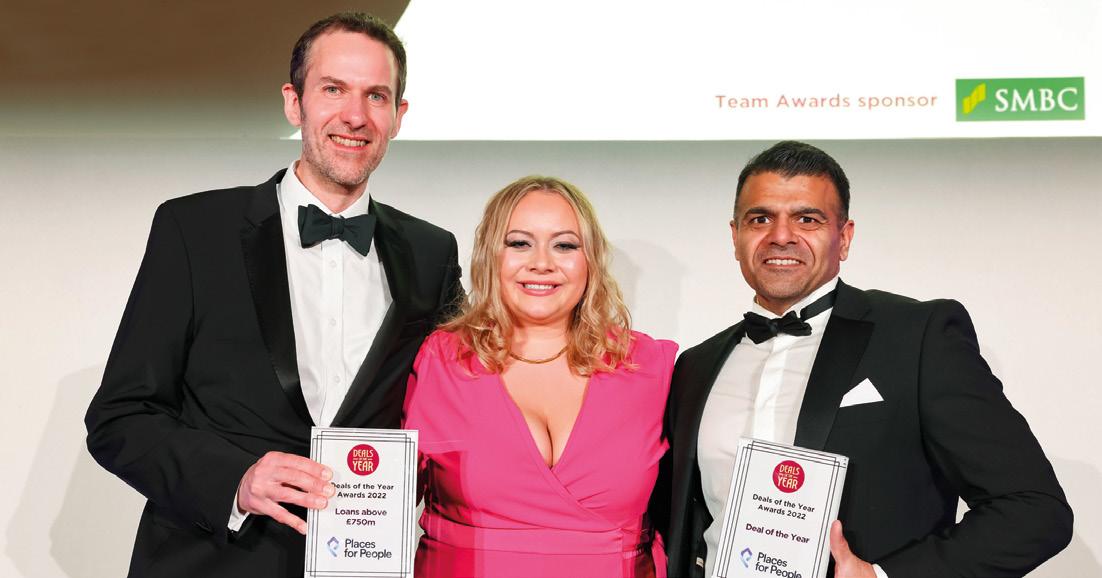
treasurers.org/thetreasurer ISSUE 2 2023 31
Philip Smith is editor of The Treasurer
View from… legal services
treasurer should be looking for more from their relationship. A few examples of what I think ‘good’ looks like:
IT: Being fairly new to the legal services profession, I might not seem the obvious person to provide a view on the relationship between lawyers and treasurers. However, during my long career in corporate banking, I worked with many different law firms and lawyers. I have therefore seen what works (and what doesn’t) from multiple angles and have experienced first hand how the treasurer/lawyer relationship is evolving. In my view, there are three fundamental deliverables, whoever the client is, and I expected these when I was the client:
• Clear advice that doesn’t sit on the fence and meets the brief – whether that be high-level views or in-depth analysis, backed up by expertise and the latest market insight in the relevant area.
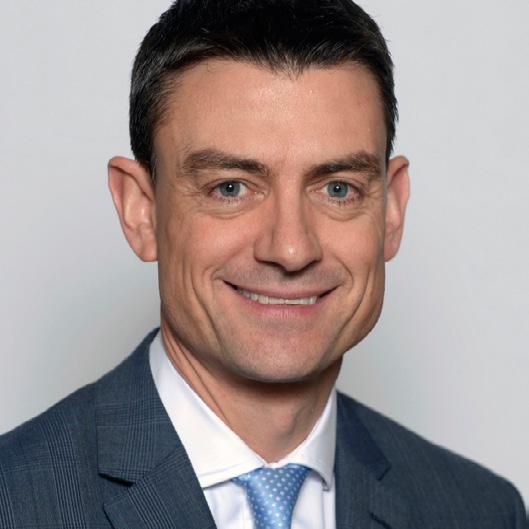

• People that you want to work with, who constantly have your best interests at heart.
• Delivery of the transaction/advice in the agreed timeframe and with cost transparency.
More specifically in the current economic and geopolitical context, a
• Commerciality: your lawyer should be immersed and networked in their market, seeing trends and developments in real time, and close to organisations that help shape market practice (such as the ACT). Taking sanctions as an example, regular and timely updates on global sanctions policies can help manage risk for any current or planned international strategies and activities, including M&A, and for the activities of overseas subsidiaries.
• Innovation: this is only valuable if it makes the client’s life easier by saving time and costs, improving efficiency, and enhancing risk control. Whether using electronic platforms for signing legal documents or AI, for example, in due diligence or document production (a current hot topic), the key goal is that the lawyer/treasurer relationship is focused on added value, by removing the commodity aspects of the role.
• Anticipation: as economic conditions have worsened, credit spreads have widened, leading to higher funding costs across
the loan and capital markets. As a result, proactively reviewing financing documentation with your legal partners can be crucial to maintaining strong relationships with your finance providers. On the other side of the balance sheet, counterparty risk over where deposits are placed is again a factor for treasurers to consider. A strong lawyer relationship can help by dynamically scanning the legal and regulatory horizon as conditions and situations evolve.
• ESG: environmental, social and governance commitments are increasingly required to satisfy corporate stakeholders. With the associated introduction of regulatory standards to encourage adoption and avoid corporate ‘greenwashing’, treasury teams have an increasing role to play and are turning to law firms, with cuttingedge experience in this field, to help them comply with regulation and to introduce and navigate sustainable finance provisions. Lawyers don’t want to do just one transaction with a client and then never work with that client again. Instead, they want to build ongoing and mutually beneficial relationships. If they can become a treasurer’s go-to trusted partner for legal advice, then the treasurer benefits from high-quality, pro-active advice from someone who understands their business.
32 ISSUE 2 2023 treasurers.org/thetreasurer
IAN TETSILL is head of debt finance strategy at Eversheds Sutherland.
Ian Tetsill
Lawyers aren’t just there for a one-off transaction; they can provide valuable pro-active advice while working with treasurers and their in-house legal teams
MT: As with most relationships, there is no one model for the relationship between the treasurer and the external lawyer. At one end of the spectrum, the relationship can be entirely transactional. At the other, the external lawyer performs a trusted adviser role, providing ongoing support on strategic issues affecting the client’s business.
In many cases, the client will have its own in-house legal function, and the external lawyer will need to be sensitive to the dynamic between the treasurer and that legal function and their expectations.
Looking at the transactional role first, the lawyer tends to become involved because the treasurer is working on a transaction that is not business as usual for the treasurer or the in-house legal function, whether a new financing, a refinancing, or a new product.
Sometimes, that is in the context of a significant event for the client, such as M&A activity or a restructuring.
In each case, the external lawyer should be able to offer both technical legal expertise and wider market knowledge of the sector or product. That market knowledge can be particularly important in periods of market dislocation. Counterparty expectations can be quite different from those at the time of a previous refinancing and the external lawyer’s role, together with other advisers, is to anticipate likely areas of focus and to assist the client in determining key objectives and red lines.
Preparation is key. Lawyers need to be sufficiently flexible to offer advice not just on Plan A, but also on Plan B and, quite possibly, Plan C. For both the treasurer and the lawyer, this requires versatility between different product types and the ability to pivot between different products if market conditions change.
Over the past few years, we have seen exponential growth in ESG products that, typically, require significant preparatory work on the part of treasurers and real interaction with other stakeholders outside the treasury function –for example, in relation to the development of key performance indicators. External lawyers should be able to bring their own experience to bear in this respect, including on the development of frameworks and potential pitfalls.

Moving from preparation to
execution, the lawyer can play a constructive role in prioritising points that are ‘must haves’ and those that can be conceded. This can extend to assisting the treasurer and in-house counsel in the communication of those issues to other stakeholders within the business, including in presenting to the board. No-one wants to get bogged down on technical issues –and the good lawyer can play a role in ensuring that this does not happen, and that execution is smooth and timetables are met.
A TRUSTED ADVISER
The transactional role will, ideally, give the external lawyer an insight into the client’s business and priorities. This will allow them to spot issues and provide value outside the strictly transactional context. Over the past decade or so, treasurers have had to adjust to huge regulatory change. The external lawyer can play a valuable role in alerting the treasurer to likely issues, enabling engagement at the consultation stage, and using their knowledge of the client to help with an assessment of the impact for the client’s business. For example, as climate change and sustainability have risen to the top of the political agenda, there has been a dramatic increase in ESGrelated legislation and regulation –and we would anticipate that this trend will only continue. Other areas of current focus include sanctions, crypto, and developments in financial markets regulation.
Beyond the regulatory space, the external lawyer can also use their transactional experience to become part of the corporate memory for the client, which is potentially valuable in assessing the implications of new developments and issue-spotting.
 MATTHEW TOBIN is head of debt capital markets at Slaughter & May.
MATTHEW TOBIN is head of debt capital markets at Slaughter & May.
treasurers.org/thetreasurer ISSUE 2 2023 33 LEGAL SERVICES
“Lawyers need to be sufficiently flexible to offer advice not just on Plan A, but also on Plan B and, quite possibly, Plan C”
MATTHEW TOBIN
Matthew Tobin
Shutterstock / Freedomz
Facing the future of treasury technology in the Middle East

APIs, blockchains and artificial intelligence are all on the agenda, but treasurers need to sell the use case and demonstrate benefits, reports Megha
Merani
34 ISSUE 2 2023 treasurers.org/thetreasurer
As the popularity of the ACT Middle East Technology and Innovation Forum 2023, in Dubai, showed, digitisation is more significant than ever in the role of the modern-day treasurer. This was borne out by the day-long conference agenda, which covered practical discussion and real-life case studies, showcasing best practice, including how treasurers can sell technology investment to internal stakeholders. Elat Niyas, treasury manager at Abu Dhabi-based family group Al Masaood, told the conference: “Selling a treasury solution internally is a challenge if there are no tangible benefits and return on investment.”
The session, moderated by Fernanda De Genaro, senior manager, corporate treasury, at Zanders, heard how treasurers must make a strong, cross-functional business case when persuading CFOs and boards of the need to invest in new systems. “Sometimes, you also have to really sell future fears, and what risks the business is exposed to,” Niyas said. “Typically, the evaluation process then measures a solution based on how easy it is to deploy and how easy it is for business teams to adapt.”
Anish Jain, chief treasury officer, MENA, at Export Trading Group, added that incidents such as fraud accelerate adoption of solutions that reduce operational risk. But otherwise, he said, most businesses don’t understand the need for technology investment in treasury. “Teams complain that they are overloaded and that they don’t have efficient ways of working, but it’s up to leadership to identify and decide what needs to be
implemented,” he said.
The other challenge, Jain added, is that the pace of technological change makes it impossible to prepare long-term business cases. “By the time you perfect and implement one solution, it’s time to go for the next one,” he said. “It is very challenging to foresee what solution and technology will fit five to 10 years down the line. We have to implement technology that helps us work more efficiently, but keep the scope open to add additional platforms.”
Necessity
A discussion on tools to manage cash in uncertain times set the focus straight: technology is becoming a necessity rather than a nice-to-have for treasurers to improve cash visibility and manage cash effectively, especially in a time of higher interest rates.
On a panel led by Caroline Stockmann, chief executive of the Association of Corporate Treasurers, Hariraj Subramanian, head of cash management at Gulf International Bank, said the requirement for technology for treasury has grown “exponentially” since COVID-19. “We’ve seen a lot more data analytics coming in,” he said. “Approving transactions isn’t enough any more. Treasurers want a full view; a strategic decision-making process through the transaction journey.”

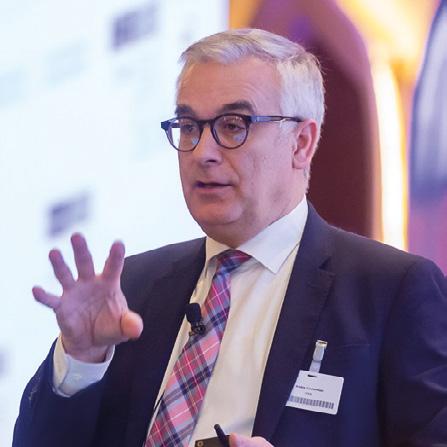
Another change coming to the region is open banking. “We see a lot of demand from large Saudi corporates embarking on an API programme for a lot of services they require,” Subramanian said. “There are also huge use cases that are coming around virtual account management,

for specific purposes, wherein they are segregated to include day-to-day activity, payroll account, refund account, rather than using multiple accounts.”
Digital bills
With the trade finance space undergoing major digital transformation, a talk by André Casterman, managing director of Casterman Advisory and board member of International Trade & Forfaiting Association, highlighted the importance of evolving legal frameworks. “Aligning policy and technology is really what the trade financing world needs,” he said. “A lot of initiatives have focused only on the technology side so far.”
In that context, Casterman said changes to the UK’s Act of Parliament concerning bills of exchange is on the horizon. “We are talking about changing the 1882 Bill of Exchange Act, to offer a digital option,” he said. “We hope it will benefit everyone when it comes to financing receivables on the back of bills of exchange in a more digital way than has been done so far. Hopefully, banks in the region can also benefit.”
A panel on new payments systems, moderated by treasury and technology expert Rahul Daswani FCT, recognised that it is not clear if virtual assets and tokenisation will converge with digitisation of existing paper infrastructure. “It could be that both progress on completely separate paths,” Daswani noted.
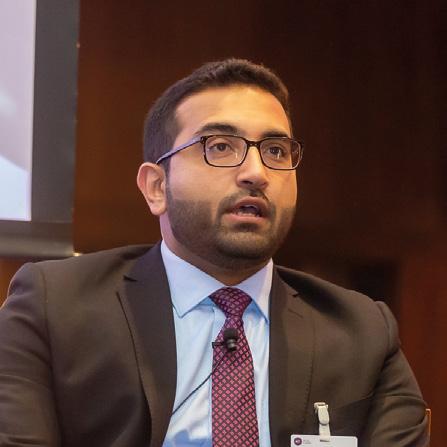
Capital markets
The conference also heard a discussion on the role of technology in the future of capital markets, facilitated by Kay French, adviser to the chairman at ADX. Ahmed Ismail, CEO and president of FLUID, told French that technologies such as blockchain, decentralised finance (DeFi) and AI are going to become critical to the industry, and businesses must begin preparing for the shifts to come. “The world is going to change whether you like it or not,” he said. “It’s really important to have the right team in place
treasurers.org/thetreasurer ISSUE 2 2023 35 TECH FOCUS Shutterstock / Rasto SK
Elat Niyas André Casterman
Anish Jain
from a blockchain and AI perspective. This is the time to be growing internally. There are a lot of new technologies and they have to be retrofitted into what you already have.
“Blockchain adds transparency, interoperability, the ability to tokenise assets and equity, and aggregate marketplaces. AI has the ability to take out monotonous boring tasks that can be replaced by algorithms and deep machine learning.”
From an issuer’s perspective, Ismail added, the ability to tokenise assets and implement blockchain, transfer assets securely and quickly, with no latency and aggregate marketplaces, holds huge potential. “When you have tokenised assets, one of the big things here is we might be able to, for example, swap Tesla shares for a share in a house, in a matter of milliseconds,” he said. “The fungibility and free movement of assets is what blockchain and Web3 enables.”
Ismail added that DeFi, in particular, is likely to “replace some very expensive investment banking bonuses with software”. DeFi refers to an emerging financial technology that is based on secure distributed ledgers, much like those used by cryptocurrencies.
The transition to tech is not without hurdles though, Ismail conceded. “A lot of companies that want to go down the route of blockchain have an issue with where to custody these assets,” he said, pointing to embattled crypto exchange FTX. “If you are a treasurer and have a million dollars
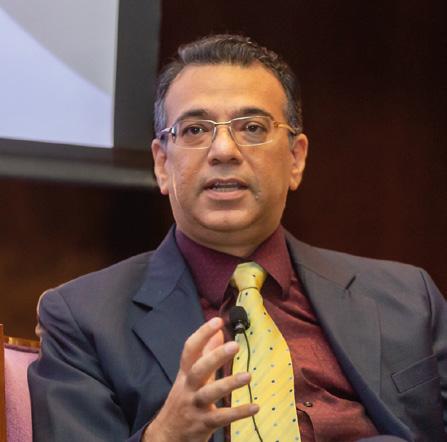

of USDC Stable Coin, you don’t really keep them on an exchange. If you did that with FTX, you’d probably be out of a job right now. It’s going to take decades for virtual assets to really pan out and overtake what we call traditional finance. But if you try to bury your head in the sand, you are going to become irrelevant.”
Metaverse
The summit concluded with a discussion on how the metaverse will impact treasurers, facilitated by Moussa Soukal, managing partner, Treasury Advisory Partners. “We will see a massive shift in about five years, with the metaverse as a part of our lives almost everywhere,” Misha Hanin, CEO and co-founder of DeepDive, told the panel.
“The speed of adoption and change in this ecosystem is 50 times faster than we’ve seen in the past. It’s not necessary that we all shift to the metaverse, but we are definitely going to use it as something that complements our lives.”

Hanin explained that, although there wasn’t an immediate treasury use case to implement, the virtual environment will alter the ways in which businesses work overall.

TECH FOCUS 36 ISSUE 2 2023 treasurers.org/thetreasurer
“It’s going to take decades for virtual assets to pan out… But if you try to bury your head in the sand, you are going to become irrelevant”
Shutterstock / JaiFotomania
Megha Merani is a freelance business and technology journalist based in Dubai
Ahmed Ismail
Rahul Daswani
The next ACT event in the region is the Middle East Treasury Summit in Dubai, 24-25 October. treasurers.org/METS23
BEST PRACTICE
Expert answers to today’s challenges
OPTIMISING CASH MANAGEMENT IN TURBULENT TIMES
Security, liquidity and return – in that order – were the themes running through this year’s ACT Cash Management Conference, as treasury professionals came together to share best practice amid growing fears of financial instability

TREASURY OPERATIONS
37
CASH MANAGEMENT
The hot topics at the conference included cyber security, the hunt for good returns and the need to ensure liquidity in volatile times
40
RECRUITING VETERANS
Former military members can make excellent recruits with project management skills and the ability to deal with complex situations
50 END NOTES
Lisa Dukes, of Dukes & King, looks forward to the ACT’s Annual Conference while looking back at the challenges of the past five years
treasurers.org/thetreasurer ISSUE 2 2023 37
It was Giles Hutson, CEO of Insignis Cash Solutions, who perhaps best summed up the attitude towards cash management in the current turbulent economic environment.
“Treasurers need to be concerned about security, liquidity and return, in that order,” he told the audience of corporate treasury professionals at the recent ACT Cash Management Conference, created with Barclays. Hutson’s comments came just an hour after the Bank of England had raised its bank rate by another 0.25 percentage points, and a day after the US Federal Reserve had made a similar move, despite growing concerns among corporates that they could be on the receiving end of a financial crisis similar to the one experienced in 2008. As Craig Inches, head of rates and cash at Royal London Asset Management, warned: “We could see contagion in the banking sector, where a sound bank can dry up very quickly.”

Against this background of concerns over bank stability, rising interest rates and stubbornly high inflation, Hutson urged treasurers to ensure they regularly update their treasury policies to ensure they remain appropriate for the current volatile environment. Speaking on the same discussion panel at the conference, Muneeza Mansuri,
assistant treasurer at Kingfisher, agreed. “Given the market turmoil over recent weeks, we certainly have had to adapt our policy,” she said.
“We have had to manage our counterparty risk very closely, monitoring on a daily basis, and report to senior management,” she continued. “Board members want to know where our money is placed, as we use a number of platforms and money market funds. But it is the security and liquidity of our cash that is the key focus. In terms of strategy, we are reaching out to place deposits with a wider group of banks.”
REDUCING CASH COLLECTION CYCLES
Inflation can have a significant impact on working capital if cash is not managed appropriately, according to Deloitte assistant director of value creation services Deniz Gunes.
“I’m guessing that cash management is at the top of your agenda,” Gunes told conference attendees, “and, if I’m guessing correctly, I can say you are not alone. In Deloitte’s recent CFO survey, we found that the percentage of CFOs who said they were aiming to increase their cashflows jumped from 28% in Q3 2022 to 43% in the fourth quarter of the year, and I wouldn’t be surprised if that number goes higher in our next survey.”
According to Gunes, in a period of inflation costs will go up faster than businesses can pass them on, leading to a “cash gap” with a net outflow of cash, even though the payables balance will probably go up as well.
He suggested treasurers could look at their organisation’s accounts payable, inventory and accounts receivable policies, to see how the gap can be closed. This could include incentives for collecting money owed sooner, renegotiating terms with suppliers, and aligning internal supply and demand for inventory.
Hutson agreed that this form of diversification was key to protecting cash in a high-interest rate and inflationary environment, though he admitted it could, at times, feel like a giant game of ‘whack-a-mole’, trying to keep up with a rapidly changing investment landscape.
“In a high-inflation environment, central banks will continue to raise interest rates and treasurers will try to get as high a yield as they can in as short a date product as possible,” said Inches. “Everyone might be getting excited about the Bank of England increasing its rate to 4.25%, but we mustn’t forget that CPI inflation in the UK is at 10.4%.”
SECURITY
Of course, bank stability is not the only form of security – cyber security was
BEST PRACTICE 38 ISSUE 2 2023 treasurers.org/thetreasurer
“The threat is real, and the risks continue to be present, so we have to be able to move quickly to protect ourselves”
Jill Harrison (right), group treasurer of Spectris
also a hot topic at the conference. “The threat is real, and the risks continue to be present, so we have to be able to move quickly to protect ourselves,” warned Scott Thorpe, director of cyber operations at Barclays.

Ransomware, where an organisation’s IT systems can be compromised until a ransom is paid, or a denial-of-service attack can pose serious liquidity risks, as well as reputational damage. Thorpe urged treasurers to stay ahead of threats and ensure there was continuous investment in their systems, especially in the new remote-working environment. “Will you be protected next week?” he asked the audience.
Technology can, of course, play a very positive role in treasury operations, and speakers at the conference described how they use technology as an enabler to manage cash in the new economic environment. “When you have a small treasury team, you have to rely on technology for the basic ‘housekeeping’,” said Jill Harrison, group treasurer for UK precision equipment manufacturer Spectris.
Kevin Cook, CEO of fintech TreasurySpring, added that technology allowed treasurers greater cash visibility, better forecasting capabilities, and the ability to quickly diversify cash holdings so that an organisation did not risk leaving its cash with a single institution –
a situation that arose with some businesses during the SVB collapse.
Harrison said her team implemented a cloud-based treasury management system in 2019, just before the pandemic, which turned out to be perfect timing. More recently, the company has gone through an ERP harmonisation process. “It will revolutionise how we do finance,” she said. “We now have an end-to-end procurement to payment system, which links in with our SWIFT connection. Spectris is invested in the improvement of automation through technology, and treasury is a key part of that.”
“It’s about visibility and control,” remarked Srini Kasturi, Barclays’ global head of digital and platforms technology, emphasising how these were vital in evolving the business.

Harrison added that the current economic environment was an opportunity to make a noise and stress the importance of treasury. “We can use this as a catalyst to show our
value,” she told the conference.
Treasury consultant and former president of the ACT Fiona Crisp, who chaired the conference, summed up how important it is that treasury is closely involved in the wider aspects of the organisation. “We are going through a period of rapid change, and treasury is an intrinsic part of that change,” she said, adding that the timing of the conference was very relevant. “Treasurers are at the sharp end of risk management involving potential, and actual, bank collapses. We were reminded that security and liquidity are key, and that senior management and the board are again asking questions of the treasury function and their policies.
“So, if you haven’t done so recently, now is the time to test and update your treasury policies, and ensure they are flexible and relevant in this changing business environment.”
treasurers.org/thetreasurer ISSUE 2 2023 39
Philip Smith is editor of The Treasurer
“In a high-inflation environment, central banks will continue to raise interest rates and treasurers will try to get as high a yield as they can in as short a date product as possible”
Deniz Gunes, Deloitte assistant director of value creation services
Srini Kasturi, Barclays global head of digital and platforms technology
MAKE RECRUITMENT A MILITARY OPERATION
Military veterans are used to achieving difficult objectives within severe time constraints, so could make ideal treasury recruits, says Haleon’s Geoff Hopkinson
Treasury remains a highly specialised function, and with the advent of innovations such as AI, blockchain and cryptocurrencies, it’s only increasing in complexity. The gut reaction for many hiring managers with vacancies in treasury roles will be to hire someone with prior knowledge and experience, from either a large accounting and audit firm or another corporate.
Sound familiar? Why do we do this? Is it because we assume that we will find a ‘diamond in the rough’ who can turbo-charge our function and solve previously unfixable problems? Or is it because we consider someone who has been through one of the Big Four accounting firms or another corporate to have the least ‘downside’ risk? The chances of them turning up and being completely useless are greatly reduced, right?
This is loss aversion at play, clear and simple. Looking back, how many of these ‘safe’ hires have been game-changers in your teams? How many have torn up the rule book or approached a problem differently, and allowed you to realise a competitive advantage that would have otherwise remained hidden?
So much of our day-to-day work is not based on specific treasury knowledge but rather on understanding, integrating with, and mentoring the business, engaging and communicating with internal and external stakeholders, and project managing people and resources to achieve objectives within constraints. This is where the opportunity exists for hiring a strong generalist, someone
who could provide your team with the added capability to push forward and reach the next level of performance. After all, if we do the same thing again and again why should we expect different results?
WHY VETERANS?
Military veterans should be high on your list as potential hires for several reasons: they are used to dealing with complexity, using their initiative, building strong relationships, and working to achieve difficult objectives within severe time constraints. Many come with a level of leadership exposure well above their industry peers of a similar age and honed project-management skills from years of managing diverse outputs.
The nature of a military career, where you change role every 24 months, means veterans are also highly adaptable and voracious learners, able to assimilate and apply complex information rapidly and in everchanging environments. Finally, they haven’t been through the ‘standardised’ process of university to Big Four to corporate and, thus, can offer fresh perspectives and experiences. Diversity isn’t just about race, religion or sex. There is also a financial benefit, as firms who employ veterans can claim relief on employers National Insurance contributions for a period of 12 months.
So, what roles could a veteran fulfil? The key is to align their strengths and experiences with the demands of the job. Take cash management, where one spends time engaging with counterparties, confirming values and value dates, reconciling differences,

40 ISSUE 2 2023 treasurers.org/thetreasurer
BEST PRACTICE
LEADERSHIP & CAREER
“Many strong performers leave to search for new challenges; these are the ones you are looking for”
and accounting for cash held on account. This aligns well with a military logistics role where you would predominantly be ordering future supplies in an electronic system, accounting for current supply stock, and collecting forecast demands from end users. Different products, but the same skill sets.
Similarly, look at a corporate finance role, where the key activities are external stakeholder engagement and relationship building, forecasting and resourcing strategic funding requirements, and the communication of treasury outputs to senior management and externals.
An ‘operations officer’ in a military unit will regularly engage with external stakeholders, often while managing conflicting commandchain dynamics, be planning to understand where their unit has spare capacity or a lack of resources, negotiating solutions for these issues, and preparing materials for the dissemination of information across the unit and to wider stakeholders – often at the same time and, generally, under tight timelines. Same skill sets, different products.
TIPS FOR HIRING
How best to hire veterans? Well, first you need to understand if there are applicants being sifted because of their unconventional background. Ask your recruiter to put all veteran CVs through, even if they don’t meet the technical requirements for the role. You can always read and reject at this point if you so wish.
Further, ask whether your organisation has a veterans’ scheme or network, as sometimes these provide a ‘side door’ to interview for this very reason. If so, ensure you have built the internal relationship and make it clear that you are open to interviewing veterans.
When it comes to CVs and interviews, don’t be drawn by rank, title, medals or awards. There are plenty of very capable junior ranks who, for one reason or another, joined the military at a level below their abilities. Performance at interview and general competency should be more important than rank achieved or time served. The promotion system within the military is time-based and, thus, many strong performers leave to search for new challenges; these are the ones you are looking for.
At interview, remember that veterans will not have had exposure to cash forecasting or other treasury skills in the same way as a
WHERE TO LOOK?
The best organisation through which to advertise any vacancies is the Forces Employment Charity (forcesemployment.org.uk). The charity has access to the full range of rank and experience through multiple avenues and sub-organisations.
Formed in 2022 through the merger of the Regular Forces Employment Association and the Officers’ Association, the charity provides life-long, life-changing support, job opportunities and training to service leavers, veterans, reservists and their families, regardless of circumstances, rank, length of service, or reason for leaving.
conventional candidate, so ask questions that allow them to showcase their experiences and transferable skills rather than specific technical competencies. If you are concerned about computer or mathematical literacy, test this at interview, but remember that they may not have used Excel in the same way you do in treasury. Remember the point about quick learners.
All military administration and organisation is completed on computers so they should be perfectly competent with Microsoft Outlook, Word and PowerPoint.
The notice period for veterans is 12 months, so if you are interviewing a candidate, they have already committed to leaving the military. As such, it is beneficial for both parties to align on expectations around timelines for starting; some may be out in one month while others may have six months or more left to serve. Being honest about expectations enables you to have a productive conversation and allows a successful candidate to approach their commanding officer to ask for ‘early release’. Aligned with this are salary expectations. While conventionally discussed at role-offer stage, you should discuss this with a veteran at interview (or earlier if possible) so they can understand whether this role is suitable. When leaving the military, many veterans also move geographically, so understanding the finances is an important part of their decision-making.
TRAINING
Finally, a note on specialist training. Veterans are entitled to a number of allowances for educational courses in their last years of service. Don’t be afraid to ask them to start a treasury-specific qualification (or be impressed if they have already done so) in the time period between hiring and starting their role. The ACT offers a number of entry-level courses and training sessions that you can signpost to if required. You may also find that many have, in preparation for leaving the military, attended other general business courses, passed the IMC, or even completed an MBA.
Geoff Hopkinson is corporate finance manager in Haleon’s treasury team. He was a Royal Marines officer for 12 years, during which time he commanded on operations in Afghanistan, Mali and the UK. Prior to joining Haleon, he studied for an MBA at the University of Warwick and completed an MBA internship with GSK


treasurers.org/thetreasurer ISSUE 2 2023 41
Shutterstock / New Africa
“The opportunity exists for hiring a strong generalist, someone who could provide your team with the added capability to push forward”
GROUP TREASURERS REMAIN IN DEMAND
How have the past three months changed in the treasury recruitment market compared with what you saw in 2022?
Last year was a record year for the treasury division of Brewer Morris. We saw a large increase in placed roles throughout the team at all levels. However, as we approached the end of 2022, with a recession looming and inflation and interest rates soaring, we were expecting a much quieter start to 2023, as budgets were being reduced and companies dialled back on their hiring.
But this has not happened in treasury, though it may have done so in other industries. Instead, the market is still very busy, with companies looking to backfill roles and make new hires as a result of expansion in the team. The main reason for this, and something that is very important to highlight, is that in times of crisis or an unprecedented economic situation, such as the one we are in at the moment, the spotlight shines on treasury professionals, especially group treasurers.
More than ever, the strategic skill set is front and centre, and clients are keen to make sure the treasurer they hire has the ability to look ahead and proactively identify where they can add value or reduce risk.


Are there any macro-economic factors that have an impact on client behaviour?
Recent fluctuations in foreign exchange rates and interest rate increases have served as timely reminders of the importance of a strategic approach to treasury. Interest rates have hit levels that we have not seen since before the Global Financial Crisis, which was now almost 15 years ago. As a result of this, many treasury professionals are having to navigate their way through high levels of interest rates and inflation for the first time in their professional careers, which has proved a challenge, especially when it comes to securing
funding for a specific project or piece of mergers and acquisitions work.
Yet it remains a good time to work in the treasury profession, and individuals can expect to see some interesting work and exciting opportunities to progress their career over the coming months and years. That being said, the current client sentiment around hiring is that the group treasurer role is highly critical in this economic climate, and there is an increased focus on making sure the right person is coming in to lead the department.
What do you think will happen during the next six months?
I believe the next six months will be very interesting for the treasury market. On the one hand, interest rates and inflation could have peaked, so this will, hopefully, be easing. On the other hand, however, the market will have to continue to deal with the fallout of SVB, Credit Suisse, and anything else that comes up in this space.
If interest rates come down to 2.9%, which the Office for Budget Responsibility predicts will happen by the end of 2023, we should see an easing of pressures on salary increases. However, if this is the case, group treasurers will still have a large focus on having to be strategic, as most organisations predict a continually challenging period over the next few years.
As a result, I believe there will be an increased focus on cash visibility and liquidity, with more specialist expertise required for raising finance and defining a group funding strategy.

SPONSORED FEATURE BEST PRACTICE
Following a record year in treasury recruitment, 2023 is set to be just as busy, despite, or perhaps because of, recessionary fears. Eliot Bates answers the key questions
LEADERSHIP & CAREER
42 ISSUE 2 2023 treasurers.org/thetreasurer
Shutterstock / 3d_man
Eliot Bates is UK head of treasury recruitment at Brewer Morris
REMOVING INEFFICIENCIES CAN PAY DIVIDENDS

DIGITAL
As the world moves towards putting the COVID-19 lockdowns behind us, we have an opportunity to reflect on the inefficiencies that certain payment systems brought to light during this difficult period. Shell was well placed in 2020, as dividend payment via paper cheques had just been fully phased out, and it had moved to paying the lion’s share of its dividend through CREST (the UK’s Central Security Depository).
However, many corporates still perpetuate these inefficiencies with the payment of dividends through conventional means, such as paper cheques or bank mandates. These experiences have given renewed impetus to distribute dividends via CREST instead. As a result, Euroclear UK & International, the owner and operator of CREST, has launched a campaign aimed at both corporates and intermediaries to employ CREST as the payment process of choice for all CREST members.
There are benefits to jumping on this bandwagon for both a corporate and its shareholders. However, before doing so, it is key to understand how the CREST distribution mechanism works. There are different approaches a corporate can take and a few approaches introduce significant exposures for a corporate. For instance, some set-ups elevate the corporate’s counterparty risk upon its registrar. In other set-ups, the corporate could even risk funding somebody else’s dividend and, consequently, not fully paying one’s own dividend.

Shell, as one of FTSE’s largest dividend payers, recognised the benefits of distributing its dividends via CREST. It carefully considered various implementation variants. This resulted in opting for a novel approach that leverages all the inherent benefits while not picking up any downside risks. Shell’s perspectives may help fellow FTSE constituents to follow suit. Equally, it may serve others that are already distributing their dividends via CREST to recalibrate their set-up after considering the pros and cons of different approaches.
The benefits of distributing dividends via the CREST system include:
• A central bank-backed cash distribution capability across pound sterling, euro, and dollar. This currency range meets the needs of most FTSE corporates and, in any case, covers the lion’s share of their dividends.
• A shareholder arranges its ability to be paid upfront via CREST. Therefore, a shareholder can always be paid a dividend by any corporate in which it may hold shares at a certain moment in time in any of its CREST Member Accounts.
• Dividend distributions via CREST automatically provide a dividend confirmation, representing a valid tax voucher, to each holder in electronic form. This removes the need for the corporate sending any additional (paper) dividend notifications to its dematerialised holders.
• Payments through CREST help to remove the need for a corporate to prefund its registrar. At the same time, its holders can still be confident of receiving their dividends first thing in the morning, avoiding any yield losses and credit risks for the corporate. About half of the companies across the FTSE 100 and 250 already distribute dividends via CREST. However, among this group, a number of different implementation set-ups are applied in practice. In considering the optimal set-up, it is advisable that the treasury team and the company’s secretariate team up and jointly discuss options with both their principal cash management bank(s) and their registrar.
This article is an extract of a detailed review of how CREST can be used for dividend payments, published online at www.treasurers.org/dividend-payments

Corporates and shareholders have the opportunity to improve efficiency and certainty in the way they make dividend payments
Shutterstock / Sutthiphong Chandaeng treasurers.org/thetreasurer ISSUE 2 2023 43
Paul Vos FCT, senior manager of treasury and corporate finance, and Anthony Clarke FCIS, deputy company secretary at Shell. Contact: paul.vos@shell.com and anthony.clarke@shell.com
Transform Treasury with the World’s Leading Platform to See, Protect, Move, and Grow Enterprise Liquidity
Kyriba enables CFOs and Treasurers to maximize growth, protect against loss from fraud and financial risk, and improve business continuity through advanced automation.
With over 2,500 clients worldwide, Kyriba delivers a secure and scalable SaaS platform to transform financial processes, unify data, and connect to the largest global network of banks, ERPs, and apps.


Learn more about how you can transform your business with
treasury@kyriba.com
www.kyriba.com



PAYMENTS CONNECTIVITY TREASURY & RISK
WORKING CAPITAL
DIARY DATES
The ACT’s calendar of events continues to grow

24-25 OCTOBER | DUBAI, UAE
ACT MIDDLE EAST TREASURY SUMMIT

Join hundreds of treasury and finance professionals at the region’s flagship event treasurers.org/mets23
8 NOVEMBER | LONDON, UK ACT ANNUAL DINNER
Celebrating 40 years, the ACT’s Annual Dinner brings the treasury community together for a memorable evening. treasurers.org/dinner23
ACT WEBINARS
Sign up for a free place at one or more of the webinars coming up over the next few months. Visit treasurers.org/events/webinars
ACT TRAINING COURSES

Join one of our virtual training courses and expand your treasury knowledge in a week or less.

19-23 JUNE
THE A-Z OF CORPORATE TREASURY
This overview of the fundamentals of treasury management is perfect for new entrants to the profession, bankers and those working alongside the treasury team. Learn about corporate treasury within the context of international markets, and build a deep insight into the core areas. learning.treasurers.org/training/ corporate-treasury
4-7 JULY
ADVANCED CASH MANAGEMENT
This course covers practical cash management, bank account structures, payables and receivables, liquidity and finance, cash management solutions and real-life case studies. learning.treasurers.org/training/ advanced-cash-management
ACT online training courses
11 JULY TREASURY IN A DAY
An introduction aimed at anyone new to treasury, looking to broaden their understanding of the function or wanting to improve their ability to have better conversations with management, operations and banks, or with treasurers as customers. In just one day, you will learn about the role of a treasurer, and will be introduced to key treasury concepts and commonly used financial instruments. learning.treasurers.org/training/ treasury-in-a-day
13 JULY
THE NUTS AND BOLTS OF CASH MANAGEMENT
In just one day, you will explore the principles and practices of cash and liquidity management, and their importance to the business and treasury function. This course will give you an overview of the role of a treasurer within the context of business. learning.treasurers.org/training/ cash-management
Preferential rates for ACT members and group discounts available. For more information, visit learning.treasurers.org/training or email learning@treasurers.org
treasurers.org/thetreasurer ISSUE 2 2023 45
BEST PRACTICE
POLICY IN PRACTICE
The members of the Policy and Technical (P&T) team at the ACT work in the public’s and profession’s interest to influence policy and ensure decisionmakers understand the impact of proposed changes to regulation and market practice on non-financial corporates. Furthermore, they work on behalf of members to provide informed and unbiased technical guidance on issues of importance to treasurers, delivered by way of technical guides, webinars, blogs and contributions to events and educational materials as appropriate.
The Policy and Technical Advisory Panel (PTAP) provides support to the P&T team, bringing insight, real-world understanding and practical guidance to the work undertaken by the P&T team.
To help corporate treasurers understand the work of the PTAP, Alison Stevens, group treasurer at Thames Water and chair of PTAP, told The Treasurer about the role of the panel and some of the issues that it has been able to influence.

AS: A large part of what PTAP does is to raise awareness and share information on key treasury issues with the P&T team. This insight feeds through to all of the different aspects of the ACT – from The Treasurer magazine to conferences, qualifications and membership.
I joined the panel in 2008, shortly after completing my Advanced Diploma, then known as the MCT qualification, as a way to connect with the ACT, grow my network, and be able to discuss the issues important to corporate treasurers. I became the chair in 2012 and, alongside chairing PTAP, also sat on the ACT Council for six years.
Influential voice
The ACT is the voice of the treasury profession, and the Policy and Technical team is instrumental in ‘being’ this voice and influencing the changes that affect corporate treasury on behalf of the membership. As a member of PTAP, I have a direct impact, and my experiences, views and insights all help to provide an on-the-ground, real-life corporate treasury perspective.
I feel my involvement with the panel, as a member and as chair, is a two-way thing. I am actively working in treasury, so I know what external factors are important and have a direct impact on the role, and what is on the horizon for corporate treasurers. For me, it is also really useful to hear from others on the panel, including the P&T team, about what they are focusing on, and why. This exchange of ideas is important, not only to ensure that we take on board different perspectives, but also to ensure that we understand what issues are affecting different industries, regions or countries, and whether there are any legal, accounting or tax developments of significance.
Diverse experience
The panel consists of a range of members, all with different backgrounds and experiences, and all happy to contribute and represent their areas of expertise. We have lawyers, tax experts and accountants on the panel, in addition to corporate treasurers. This diversity ensures that we can hear from others about the implications of changes and have a rounded view on how this will impact corporate treasurers, their businesses and those who work with them. The panel meets four times a year and, as
46 ISSUE 2 2023 treasurers.org/thetreasurer BEST PRACTICE
The ACT’s Policy and Technical Advisory Panel contributes a wealth of real-world experience, insight and support to the treasury community, according to Alison Stevens
LEADERSHIP & CAREER
Alison Stevens
with many panels, we now do this online. The meetings last for about two hours and consist of: a discussion on the notes from the last meeting, with actions; an update on topics for ACT initiatives, especially for upcoming conferences; in-depth discussions on key issues; an open forum, where we horizon scan; and an update from the P&T team on meetings/consultations with regulators, industry forums and the media.
Examples of the breadth of topics that may be covered at the meetings include: Macro-economic developments: the impact of interest rate rises, currency volatility, and the difficulty in recruitment, all of which would have an impact on an organisation.
ESG: this is an area that continues to develop rapidly, and topics that we have discussed include ESG reporting, best practice, and sustainability. The regulations around ESG are evolving, and we have discussed the EU taxonomy and how this is being advanced, along with the risks around green washing. Technology: in particular, implications of developments in cryptocurrencies, AI, such as ChatGPT, and TMS. Regarding regulatory work, an example of a recent consultation for discussion during a PTAP meeting

Influencing power
In her time as chair of the PTAP, Alison Stevens has been involved in a number of initiatives. Here, she sets out the ones where she feels they had the most influence:
Hedge accounting
We were involved with understanding the impact of IAS 39 Financial Instruments: Recognition and Measurement on corporates, influencing how the standard could be interpreted and managed in practice for those working in corporate treasuries. We made the accounting bodies and regulators aware of the difficulties with IAS 39 by articulating the problems corporate treasurers faced, how the changes affected treasurers, and what changes would be helpful.
was HM Treasury’s payments landscape review. The government was seeking answers to specific questions to gauge opportunities, gaps and risks that need to be addressed to ensure that the UK provides cutting-edge payments technology. As an increasing number of consumers use card, mobile and electronic wallets to make payments, there is a need to ensure the end users, as well as the wider economy, benefit to the fullest extent from the payments networks. The P&T team was collating information to answer these questions, and PTAP provided input into this.
To read the latest information from the Policy and Technical team visit the technical resources page treasurers.org/hub/technical and to read the latest blogs from the team go to treasurers.org/blog
In terms of the media, PTAP also provides insights to enable the P&T team to respond authoritatively when approached by journalists from the financial media.
IAS 39 was initially developed as an accounting standard that didn’t take into account the impact on corporate treasurers. But through discussions with the ACT, we were able to ensure that the treasurers’ perspective was understood and incorporated in reforms to the hedge accounting standards, which have since taken place (IFRS 9 Financial Instruments). We have continued to contribute to the debate as the accounting standards continue to evolve.
LIBOR
We were able to explain to the official sector how corporates use LIBOR and its importance for corporate treasurers. The implications of transitioning away from LIBOR, not least
in terms of risk management, could, therefore, be factored in and solutions developed to accommodate corporate requirements.
Money market funds (MMF)
Corporates use MMFs for cash investment as a low-risk investment. Since the 2008 financial crisis, reforms were proposed that would have meant money market funds would no longer be constant Net Asset Value funds and value would change, in line with market value. As a result of the intervention of market participants and the ACT, low-volatility funds were permitted that preserve the constant Net Asset Value in most situations, so reflecting the needs of corporates using MMFs.
Louise Tatham is head of professional development at the ACT
A DAY IN THE LIFE: IHG HOTELS & RESORTS
With more than 6,000 hotels in over 100 countries, there’s never a dull day for the award-winning treasury team at IHG, says group treasurer
 Hailey Laverty
Hailey Laverty
IHG can trace its history back to 1777, when William Bass opened his first brewery in Branston, Burton-on-Trent, UK. Although the company has been through many changes since then, effectively becoming a ‘hotel company’ only in 2003, the treasury team, along with many of IHG’s other global finance teams, remain in Branston today.
As group treasurer, I report to the SVP group financial controller – along with the tax, financial reporting, financial governance, finance operations and information delivery teams. The treasury team consists of a frontoffice team of four, along with the US treasury team of three, who provide banking services for the US-managed hotels. Our treasury accounting and reporting team of three are managed through our financial reporting structure. In 2022, we added a treasury systems manager, which we decided was necessary to manage the ongoing integration of our new TMS and payments platform.
We have a very centralised treasury model. All subsidiary entity cashflows are overseen by our group treasury team. On a daily basis, our team works closely with our business service centre, which is based in Gurugram, India, to pool and move cash between subsidiaries to ensure we are managing cash and FX efficiently on a day-to-day basis.
Overall, we have been managing cash balances of more than $1bn for the last couple of years, which is relatively
unusual for IHG. During 2020, we issued two bonds to increase liquidity, followed by very strong free cash flow of more than $500m in 2021 and 2022.
EXOTIC LOCATIONS
It is worth noting that we are an asset-light business, IHG does not own the hotels, we either franchise or manage the hotels on behalf of third-party owners – and less than 1% of hotels are either owned or leased. So from a treasury perspective, we are not dealing with cashflows from 6,000 hotels, but the fee revenue stream that we receive from them.
We are always adding new hotels in exciting countries. As you can imagine, some of the hotels are in quite exotic locations, which can make sourcing new banks to provide cash management services to our subsidiary entities a bit tricky at times.
Our US team does provide banking services for our managed hotels in the US, which involves managing accounts at more than 60 US banks for 200 hotels. Our team doesn’t have the option to reduce the number of banks, as they are chosen by our hotel owners – and as we are constantly adding new hotels, this certainly keeps the team very busy.
Our major brands include InterContinental Hotels & Resorts, Holiday Inn Express, Crowne Plaza, Kimpton and Six Senses. We have also recently developed new brands, including voco and avid. In all, we have more than 6,000 hotels in over 100 countries, 18 hotel brands across the luxury and lifestyle, premium and essentials markets, with another 1,800 hotels in the pipeline.
WORKING CULTURE
Currently, we have a hybrid-working model where we are in the office two days per week – usually, we try to work the same days as a team and when our other teams, such as financial reporting and tax, are also in. We have a great culture in our office, helped by the games room – we have regular pool and table tennis tournaments – and a gym.
When we added the new team member responsible for systems and processes, we opened up recruitment internally and externally, but, in the end, decided recruiting internally from our FP&A team was the most sensible decision. It meant the person already had knowledge of IHG and could develop the systems knowledge. Our senior analyst in the
48 ISSUE 2 2023 treasurers.org/thetreasurer
BEST PRACTICE
& CAREER
LEADERSHIP
Hailey Laverty, second left, with the awardwinning IHG treasury team
front-office team also left to pursue an external opportunity – we don’t have a lot of turnover in our team usually, so this generated some opportunities for people within the office. Our dealer was promoted to senior analyst, and our new dealer was also recruited internally.
Our US team had some changes, too, with one new external recruit. They also provided a secondment opportunity for someone from the wider finance team to broaden their skill set. We also recruited an intern as part of the Leonard Cheshire Change 100 programme, which offers internships for students and graduates with disabilities or long-term conditions. The placement was very successful, and our intern is still with us.
IHG gives us two free days a year for volunteering leave. Our front-office manager, Bert, spent two days volunteering at COVID vaccination centres, a continuation of volunteering he did in the previous year.
I am also the Branston office representative for Out & Open, which gives employees an opportunity to participate in LGBTQ+ focused conversations and activities. The highlight of 2022 was IHG’s participation in the London Pride parade for the first time.


AWARD WINNERS
We were thrilled to win the medium-sized team award at this year’s ACT Deals of the Year awards – it capped what had been a
IN NUMBERS
6,164 open hotels

911,627 open rooms $3.892bn total revenue (2022) $628m operating profit (2022)
busy year for the team. We had successfully refinanced our $1.275bn syndicated and $75m bilateral revolving credit facilities, and got our credit rating upgraded, back to its preCOVID level. We also focused on completing elements of the TMS implementation that had started in 2021, which included 45 intra-US intercompany loans, which had previously been managed outside our TMS, alongside the management of a $500m share buyback programme in terms of cashflows and FX hedging requirements. We also went through a UK cash management RFP for our UK treasury and payments.
Then there was the outbreak of war in Ukraine. The exit from Russia was obviously something very sudden and unexpected –and initially required almost daily calls with our cash management banks and wider IHG legal teams, as we needed to understand the impact of changing regulations.
Looking ahead, we have got a very full list of activities planned in 2023, including more cash management RFPs, including in China, so that will be very interesting. Our problem is what activities to prioritise because, the fact is, treasury is never dull, so there will probably always be something that comes out of left field from the business that we weren’t expecting. So, while we have a big list of things we would like to do, we know that we also need to keep space for those surprise projects!
treasurers.org/thetreasurer ISSUE 2 2023 49
Hailey Laverty is group treasurer of IHG Hotels & Resorts
IHG’s InterContinental Rome Ambasciatori Palace
IHG at London Pride 2022
THE NEW MODUS OPERANDI
As I am sure you are all aware, the 20th ACT Conference will start on 16 May, at the ICC Wales, in Newport. Its theme, managing risk in times of crisis, is very topical. The past five years, in particular, have provided no end of opportunities to challenge our skills as treasurers and, perhaps, have also given us many reasons to challenge the current ways we manage risk, often taking us out of our comfort zone.
In an article in Issue 4 2022 of The Treasurer, “Navigating FX Risk Management in a Volatile World”, we covered the challenges faced within foreign exchange risk management, from policy design to more complex and practical considerations – noting that the time of passive acquiescence was over, with active management and proactivity becoming increasingly invaluable. This sentiment can be extended to other risks and specialities that we, as treasurers, consider, manage and optimise daily, all of which may test us during times of crisis.
If we cast our mind back over the past five years, the moments to pause and take stock have been few and far between – focusing on mastering the basic foundations, rolling with the challenges, adapting and being ready to capture opportunities will become the new modus operandi of treasurers.


Increasingly, I am asked what the balance should be between proactivity and reactivity and where we should maintain the status quo versus embracing innovation and change. It is becoming increasingly apparent that if we wait until a crisis hits before focusing on the details and appropriateness of treasury risk management, then it has most likely been left far too late to mitigate risk and capture opportunities. To put it more simply, be proactive and drive innovation to be ready for change.
With this mind, I encourage everyone to be front-footed and innovate using our core skills as treasurers. It is only by questioning the
status quo and not just blindly accepting the existing policy and controls that we can grasp opportunities and value. This statement in itself is easy to make, but, in practice, challenging the existing approach can take commitment, resource and confidence in conviction.
Instead of relying on the policy ‘because it has always been that way’, try starting with a blank page, going back to basics, identifying and analysing the risks the company faces in the new world where we operate. Assess the challenges that have been faced and forecast what could go wrong in the future – design policy, controls and procedures appropriately in response. Consider how best to balance flexibility and delegation to ensure hands are not tied when action is needed in times of stress. Use best-practice frameworks, such the FX Global Code of Conduct (bit.ly/ fxconduct), as well as published resources and wider treasury community peer support.
When trying to ‘future-proof’, it is often hard to envisage beyond the next few years, so, instead, consider it as a rolling five-year framework. Perhaps push sensitivities, risks and opportunities wider than one ordinarily might do, and aim for a position of strength in readiness for any future scenarios. Visualisation and planning are key to dealing with any crisis; getting this outlined early, even if not perfect, should be very helpful if ultimately required –and if nothing else it demonstrates foresight and proactivity!
To paraphrase writer Ernest Hemingway, change happens gradually and then suddenly. It’s a phrase that is very apt for current markets, particularly in a late stage of an economic cycle.
I look forward to seeing you in Wales.
50 ISSUE 2 2023 treasurers.org/thetreasurer
Lisa Dukes is co-founder of Dukes & King
Shutterstock / ozalpvahid BEST PRACTICE
“Try starting with a blank page, going back to basics, identifying and analysing the risks”
RISK MANAGEMENT & STRATEGY



























ARE INVESTORS AWARE OF YOUR ESG CREDENTIALS?
Sustainable Fitch can help you differentiate your company and highlight its sustainability achievements with our holistic ESG Ratings and Second-Party Opinions.
ESG Ratings from Sustainable Fitch are among the first products to provide a quantitative and qualitative assessment of an entity or transaction’s impact on environmental, social, and governance matters, according to third-party published principles and guidelines.

For sustainable bonds and loans, a Second-Party Opinion (SPO) from Sustainable Fitch provides an opinion that a debt instrument framework aligns with accepted market principles, backed by our rigorous analysis.
To learn more, visit www.SustainableFitch.com or contact us at info@sustainablefitch.com



































































 MATTHEW TOBIN is head of debt capital markets at Slaughter & May.
MATTHEW TOBIN is head of debt capital markets at Slaughter & May.
































 Hailey Laverty
Hailey Laverty































